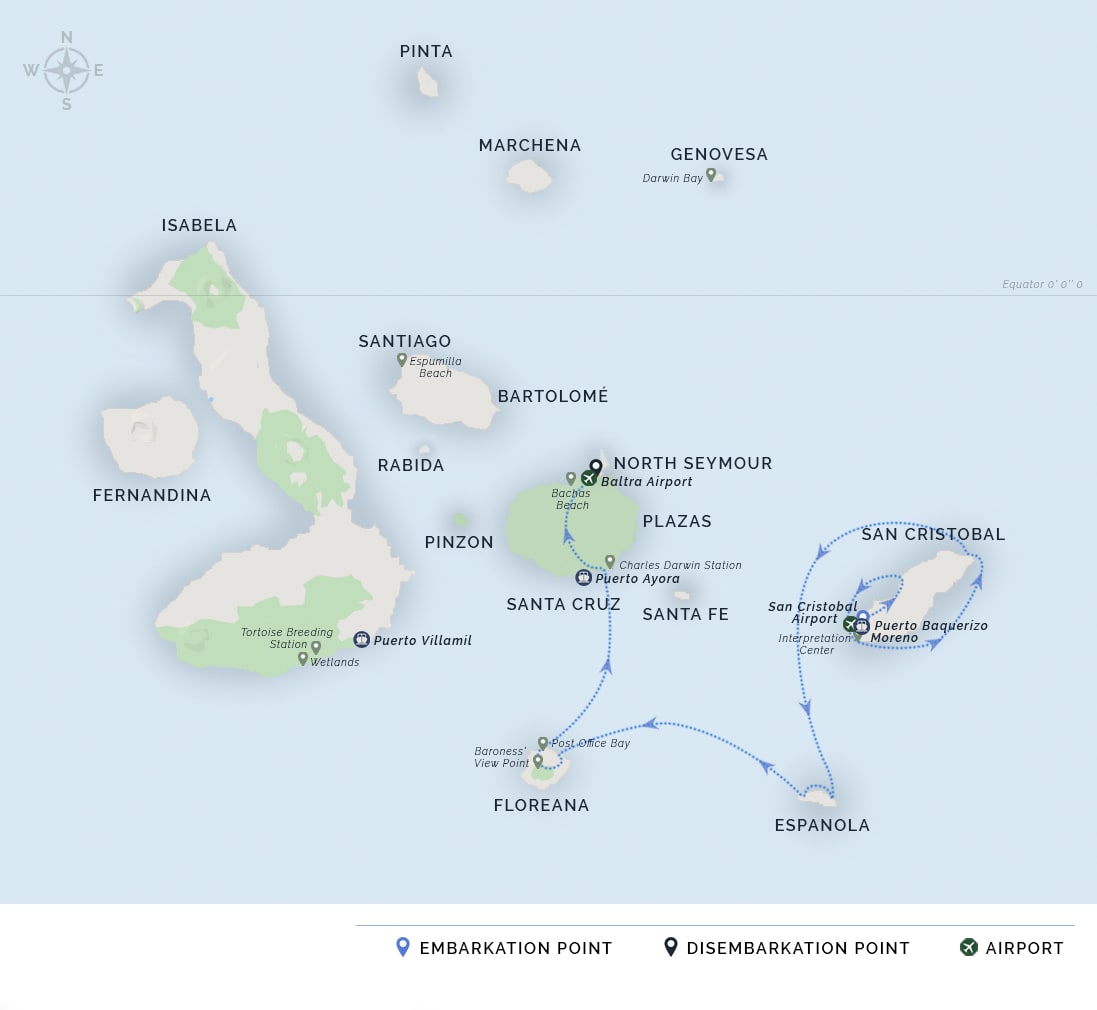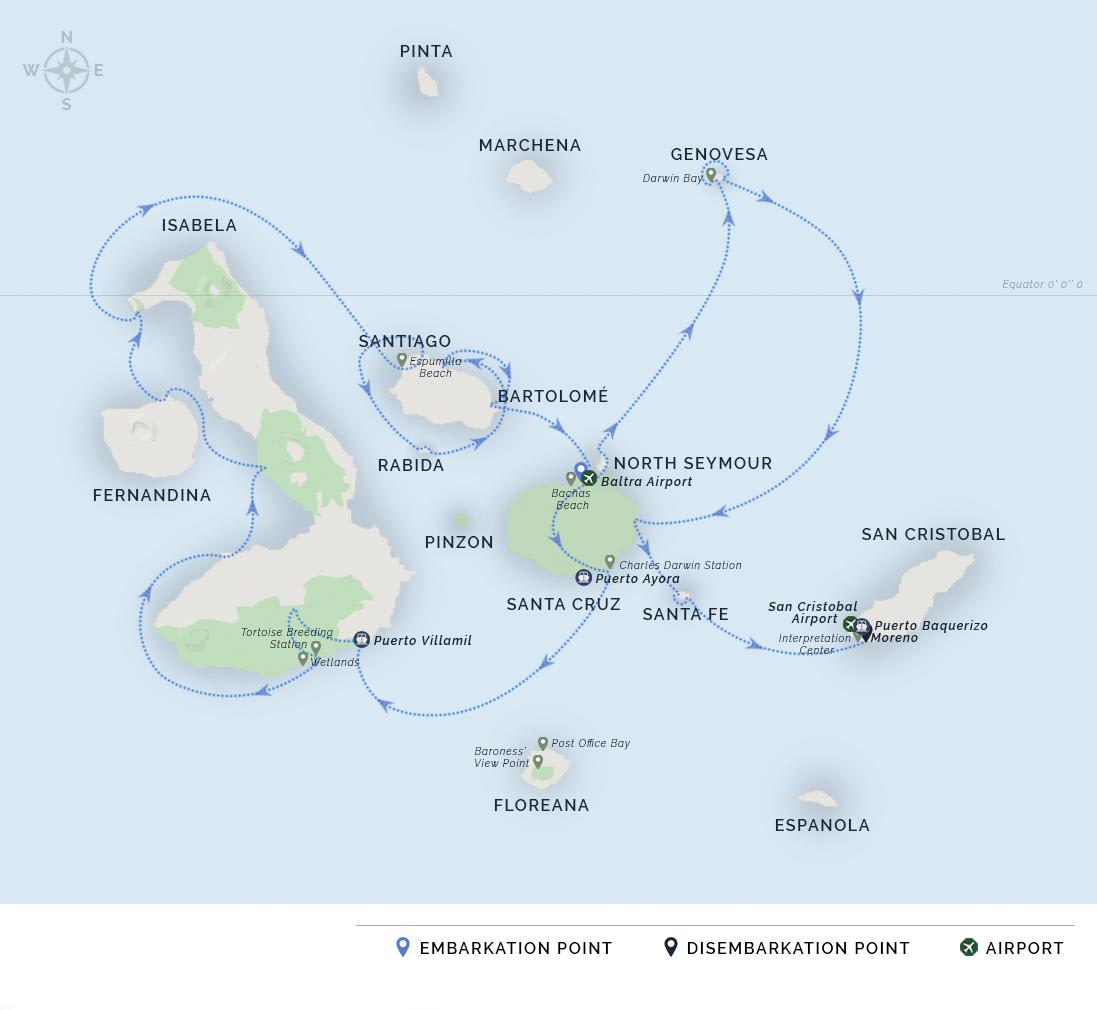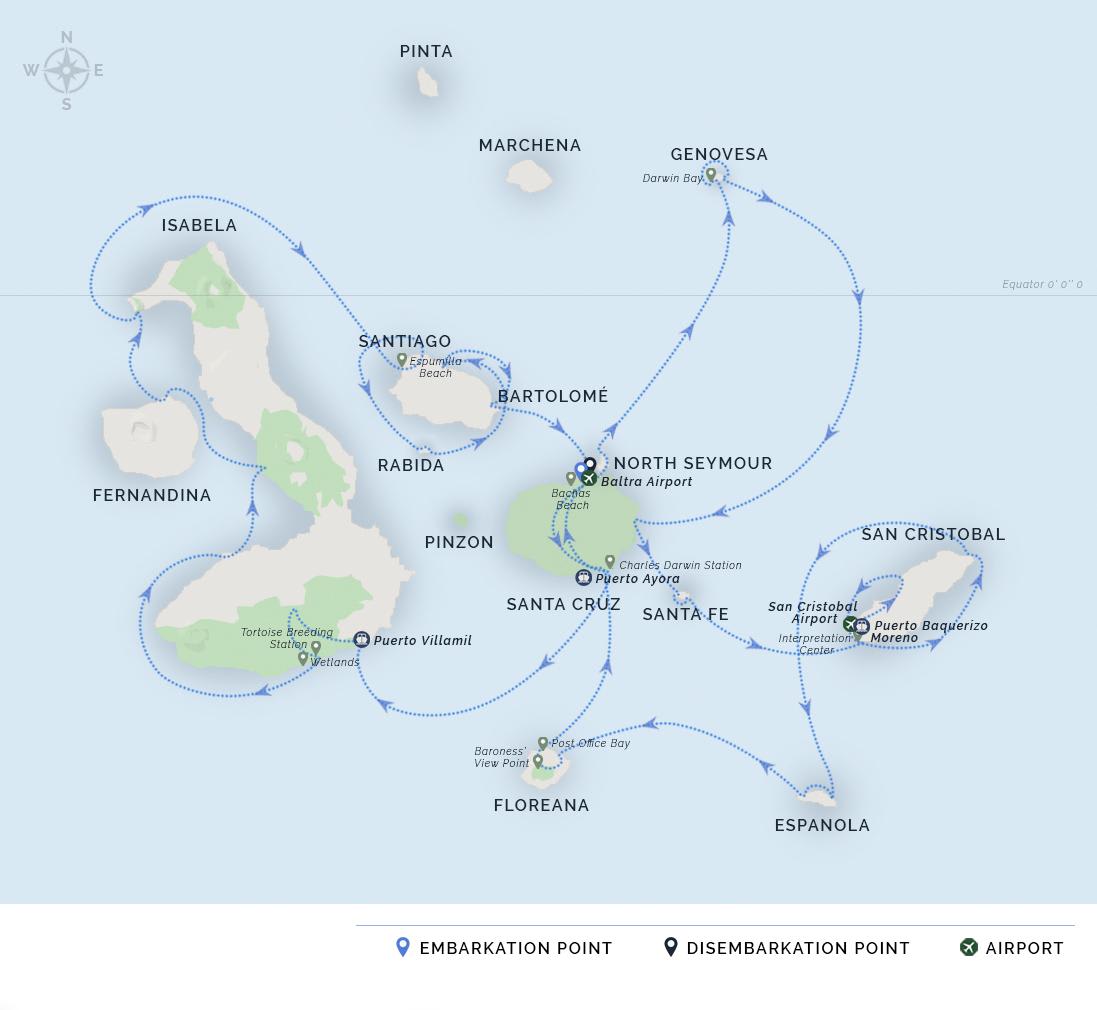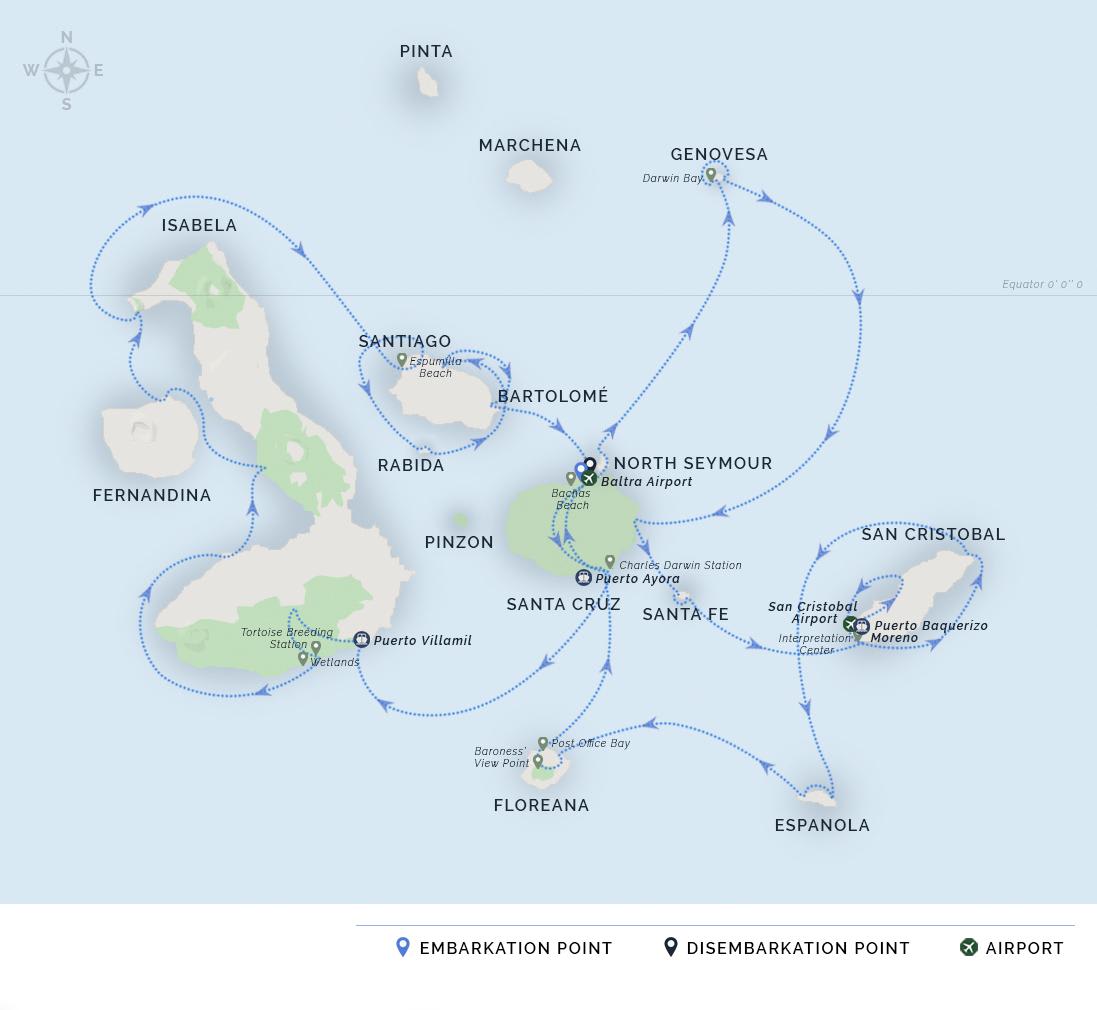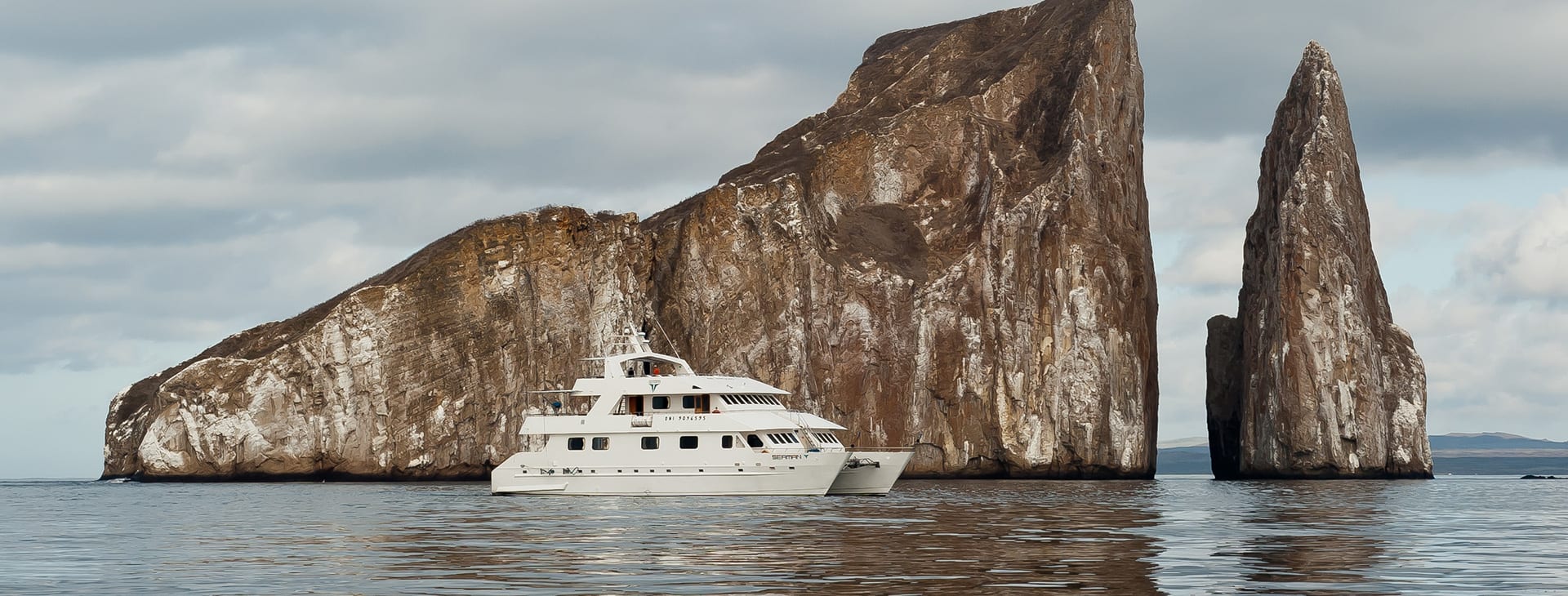
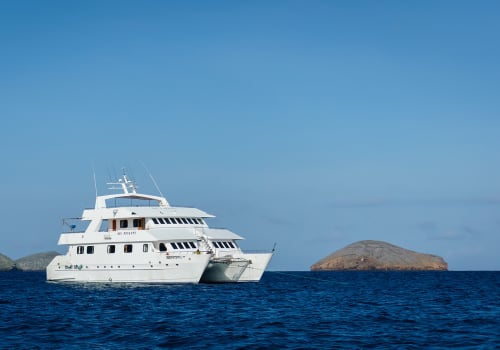
-
Family
-
Solo
Overview
Have you dreamed of sailing through the Galapagos Islands with the wind in your hair while frigate-birds soar overhead and dolphins race alongside? The twin-hulled catamaran Seaman Journey makes that vision come true for up to 16 passengers in eight cabins.
Life Aboard The Seaman Journey Catamaran
At 90 feet in length, the Seaman Journey is a boutique ship that is big on both style and comfort. The intimate size makes this the ideal vessel for bonding with family and friends and building a sense of camaraderie with fellow sailors. The ship’s spacious sundeck invites you to take a midday nap on a lounge chair, flip through the pages of a good book while keeping an eye out for wildlife spottings, or watch the sun set into the ocean.
Indoors, stop by the well-stocked bar for a beverage before sinking into a plush sofa to reflect on the day’s adventures. With a careful mix of social and quiet areas, you are sure to find your perfect way to unwind between excursions. At the end of each day, be sure to attend the nature lecture hosted by the ships’ English-speaking certified naturist guide. These discussions are a chance to learn about the history and wildlife of the area, ask questions about what you saw during previous excursions and get a sneak peek into the next day’s activities.
The new kid’s program aboard Seaman Journey now provides an even more engaging and educational adventure for younger explorers than ever before. Through interactive multimedia materials, children will discover and learn about the unique environments they visit, making their journey truly memorable.
Excursions From Your Seaman Journey Galapagos Cruise
Are you hoping to discover specific islands within the Galapagos on a schedule-friendly cruise? The Seaman Journey offers four-, five- and seven-night options, each focusing on a few islands. But, why choose? If you want the ultimate experience of touring the vast majority of the region, combine all the shorter itineraries into one epic 14-night adventure. Your journey could start with a visit to the Interpretation Center at Charles Darwin Center on San Cristobal Islands.
This museum is a must-see for establishing a solid understanding of the Galapagos Islands. During a visit to Suarez Point on Española Island, you may watch the famous blowhole shoot water up to 245 feet into the air and see albatrosses use the cliff face as a launchpad for their soaring flights. Not to be missed is a stop on Rábida Island, where a short walk leads to a secluded lagoon filled with bright pink flamingoes. No matter which route you select, your days will be filled with dinghy rides, snorkeling, kayaking, and time at the beach.
Fine Dining Aboard The Seaman Journey Catamaran
No holiday is complete without exquisite meals, and the crew of the Seaman Journey ensures you are delighted with every bite. The ship’s chef uses top-quality local ingredients to create both international and local specialties. Each meal presents a choice of meat, poultry, or seafood. The chef is also happy to accommodate food allergies and dietary restrictions.
For creating family memories, exploring one of the world’s most sought-after travel destinations, or disconnecting from your hectic day-to-day routine, a Seaman Journey Galapagos cruise is the experience you are craving. The ship’s friendly nine-person crew is ready to welcome you aboard.
Itineraries & Prices
All itineraries are subject to change due to seasonal weather conditions (and resultant variations in river and tributary water levels) affecting accessibility to locations. Thus navigation routes, times and excursions may need to be modified at the cruise captain’s or your guide's discretion.
Embarkation
AM: This day you will y from Quito, Ecuador to the Galapagos. Due to the Galapagos Government, a fee of 20 USD must be paid for the migration control card. Afterward, you will enjoy a quick 4-hour flight, with a quick stop at Guayaquil. Once in San Cristobal, passengers must go through an inspection point at the airport to make sure that no foreign plants or animals are being introduced to the archipelago. Also, this inspection point is where passengers have to pay for the entrance to the Galapagos National Park under the following parameters: Adult Passengers $100 and Children $50 (under 12 years old) Later on, our guide will pick you up and carry the luggage to the bus from the port that transports the passengers to the Seaman Journey Catamaran on a motorized boat called a panga.
PM: This is an interpretation center with exuberant gardens and stunning ocean views. Visitors at the interpretation center can learn a lot from the geological and human history of the islands, conservation facts, and natural history. This is the oldest museum of Natural History in the Galapagos Islands which attempts to preserve the archipelago. It is indeed inspiring and motivating to watch and learn all of their research and attempts.
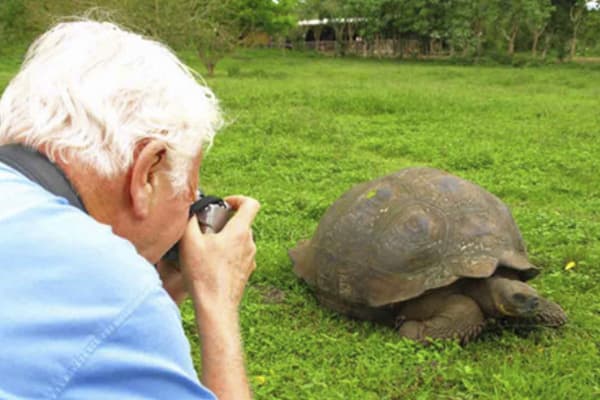
San Cristóbal & Lobos Island
AM: Punta Pitt, located at the eastern end of San Cristobal Island, features a 90-meter beach and several natural viewpoints overlooking an eroded hill of volcanic tuff. A 1,400-meter trail leads from Oliviana Beach to the hilltop, showcasing vibrant colors from various types of lava. Strong winds have created stunning landscapes reminiscent of a science fiction movie. Oliviana Beach's sand, adorned with bright crystals from lava erosion and shells, provides a sunbathing spot for sea lions. Here, you can observe frigate birds, pelicans, herons, and seagulls. Punta Pitt is one of the few places where you can see all three species of boobies—blue-footed, red-footed, and masked along with two species of frigate birds.
PM: Isla Lobos is a small, flat islet known for its sea lion population, which frolics on the white sand beach. Located about 20 minutes by boat from Puerto Baquerizo Moreno, the island offers excellent snorkeling opportunities. Two strands of beach provide access for tourists to explore the underwater world alongside sea lions. An 850- meter trail connects the brush and features saltwater-tolerant coastal vegetation. It is an important nesting site for blue-footed boobies and frigate birds. One of the easiest islands to walk on as it is flat and everything is very close.
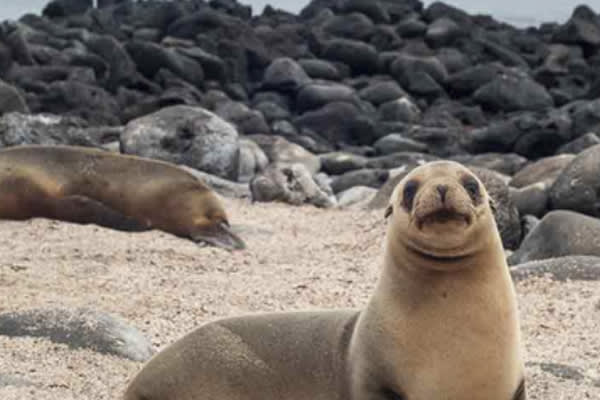
Gardner Bay & Suarez Point
AM: Gardner Bay, located on the northeastern coast of Hood Island, features a beautiful beach for relaxing, swimming, and kayaking. You can spot sea lions, swim with sea turtles and even glimpse small white-tip reef sharks in the clear waters. In this area, you can observe three species of Darwin finches. Both resident and migratory birds populate this region.
PM: Suarez Point is ideal for spotting blue-footed boobies, albatrosses, and Nazca boobies. Set along the oceanfront, this beautiful site features large waved albatrosses launching from cliffs. A famous blowhole here shoots water 50 to 75 meters into the air, offering fantastic photography opportunities.

Cormorant Point & Post Office Bay
AM: Cormorant Point likely boasts the best flamingo lagoon in the Galapagos, nestled between two tuff lava cones. You can observe various shorebirds, including common stilts and white-cheeked pintail ducks, alongside the flamingos. The area features two distinct beaches: "Green Beach," with its olivine crystal sand, and "Flour Sand Beach," made of coral. After your exploration, the group will visit Champion Islet, a prime spot for snorkeling with sea turtles, sea lions, and vibrant fish among the nearby coral reefs.
PM: Post Office Bay houses a wooden barrel placed by a whaling ship in the 18th century, serving as a makeshift post office for mariners and tourists. Visitors can hand-deliver letters or postcards. This site also marks the landing area for some of the first colonists. Spend the afternoon relaxing on the beach and enjoying the beauty of the Galapagos.
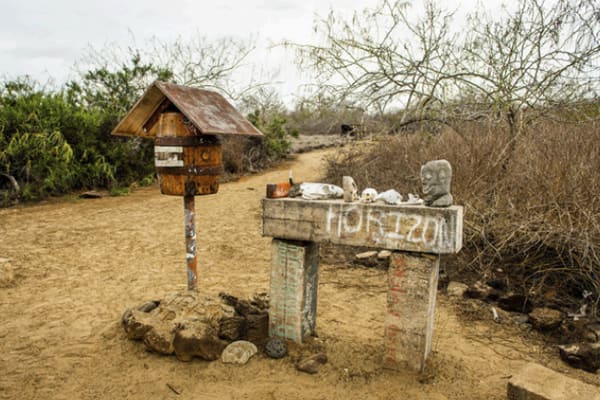
Disembarkation
AM: The Fausto Llerena Breeding Centre, located in the Galapagos National Park on Charles Darwin Avenue, is a 40-minute walk from Gus Angermeyer Tourist Pier. Start your visit at the Galapagos National Park Service information booth. Follow the trail to the Van Straelen Interpretation Centre, then to the breeding center. An elevated wooden path allows you to view several species of Santa Cruz tortoises and the tortoises of Española Island, culminating at the baby- tortoise breeding corral. After your visit, you will transfer to Baltra airport for your flight back to the mainland.

Embarkation
AM: This day you will fly from Quito, Ecuador to the Galapagos. Due to the Galapagos Government, a fee of 20 USD must be paid for the migration control card. Afterward, you will enjoy a quick 4-hour flight, with a quick stop at Guayaquil.
Once in Santa Cruz, passengers must go through an inspection point at the airport to make sure that no foreign plants or animals are being introduced to the archipelago. Also, this inspection point is where passengers have to pay for the entrance to the Galapagos National Park under the following parameters: Adult Passengers $100 and Children $50 (under 12 years old).
Our guide will pick you up and will carry your luggage to the bus that transports the tourists to the ferries to cross the Itabaca Channel, after this passengers will be taken by another bus to the first visit to Ranch Manzanillo where visitors should wear comfortable walking shoes, light clothing and to carry a waterproof jacket, sun-block lotion, a camera and repellent for the first activity. The visit to Ranch Manzanillo includes a picnic lunch and a short walk before going on board the Motor Catamaran. It is important to follow these instructions to accomplish this itinerary properly. Also, please be aware that passenger´s luggage will be sent directly to the Seaman Journey yacht.
PM: Journeying across Santa Cruz into the highlands visitors are delighted by the island’s variety of life and geology. Beginning at the coast and traveling across Santa Cruz the road departs from Puerto Ayora climbing through the agricultural lands and into the mist-covered forests. Santa Cruz possesses all of the various life zones present in the archipelago. Birds will surround you across this path. Whether it’s the bright red feathers of a vermillion flycatcher or one of Darwin’s Finch almost every bird present in the islands can be found here. Santa Cruz offers excellent opportunities to observe the wild Galapagos Tortoises. Tracking tortoises is not the only exciting activity to be found in the highlands. There are also plenty of lava tubes, sinkholes, and craters ready to be explored.

Punta Moreno & Mangle Point
AM: Punta Moreno is located on the north coast of Isabela Island between the volcano Sierra Negra and Cerro Azul volcano. The trail runs along with a lava flow Pahohoe (solidified lava in the form of corrugated or an accordion) into a complex of coastal lagoons, where several species of birds can be found around these lakes and mangroves.
PM: Off the eastern coast of Fernandina, Mangle Point can be found, a superior snorkeling site and a beautiful location for riding in a panga or zodiac through a grove of mangrove trees. A hike of about 1/2 miles is possible. While you are on your ride, you are likely to see sea lions, tortoises, pelicans, rays, and birds too numerous to name them all.

Urbina Bay & Tagus Cove
AM: Urbina Bay is located at the base of Alcedo Volcano on the west coast, between Tagus Cove and Elizabeth Bay. This area experienced a major uplift in 1954, which caused the land to rise over 16 feet. The coast expanded half a mile out, leaving marine life stranded on the new shore. This area is also a great place to snorkel. Urbina Bay is a path that starts with a wet landing. The course is approximately 3200m and made up of sand, pumice, lava, coral, and vegetation where one can observe iguana burrows. It is an ideal place to see red and blue lobster!
In Bahia Urbina, you can see Darwin’s finches. Its main attraction is the land iguanas, which are larger than in places like South Plaza Island and Galapagos tortoises also in the wild, sometimes even out of season, they are on the bottom of the islands.A large amount of vegetation can be observed such as chamomile and Rosewood, but among all these plants, the beautiful flowers of cotton Darwin, endemic to the Galapagos Islands stand out.
PM: Tagus Cove is located west of Darwin Volcano on Isabela Island. This was a favorite spot for pirates and whalers, and it was them who started the following tradition: the inscription of the names of boats. At the beginning of the trail, you will see a small cave where you will find inscriptions dating to the 1800s.
Its name originated from a British warship that went across the islands in 1814 looking for Galapagos Tortoise for food. Due to former eruptions, the substrate has a large number of volcanic rocks of different sizes, among the most common, are little balls of the nearly spherical shape known as the “lapilli” or petrified rain.

Espinoza Point & Vicente Roca Point
AM: Espinoza Point is a famous place known for its large colonies of marine iguanas and as the habitat of unique species like the flightless cormorant, Galapagos penguin, Galapagos hawk, and Galapagos snake.
PM: One of the most impressive and spectacular places of the enchanted Galapagos Islands; with high cliffs and tuff stone, ash, and lava formations that give this area a majestic touch, is Punta Vicente Roca. It is located on the north-western coast of the island; comprises two distinct islets. This large bay has spectacular marine life.
Here, you can see seahorses, sea turtles, and the strange yet fascinating Mola-mola or sunfish. This bay is a great place to practice Panga Ride and Snorkeling. We can also find Penguins, Blue-footed boobies, Terns, Boobies, Sea lions. Also, you can snorkel and observe sea turtles, stingrays, and pufferfish.

Espumilla Beach, Bucanero & Puerto Egas
AM: Espumilla Beach is located on the northern coast of Santiago Island in James Bay. During the last presence of the El Niño phenomenon, one of the two lagoons in this site, underwent a process of sedimentation, thus causing the disappearance of a representative colony of flamingos. The main attractions are the Palo Santo forest and the nesting of baby turtles.
PM: Cerro Brujo is a beautiful white coral beach where you can swim and watch birds and sea lions, plus you can snorkel. This is the first coast where Charles Darwin ever walked on in 1835. In this marvelous lava landscape, you can see seabirds like blue-footed boobies, Nazca boobies, herons, frigate birds, and shorebirds. The protected bay is very popular to observe young tortoises and for swimming. The pools with salty water behind the dunes were used by the fishermen as a salt mine to preserve food for the local population. Among the fauna, you can observe the Chatham Mockingbird and the San Cristobal Lava Lizard, both species being endemic to the island and unique to the area as they can be observed nowhere else.
Furthermore, you can find the island canary, the Galapagos turtles and with luck the little bird known as the Pájaro Brujo in Spanish, an endemic species from San Cristobal Island. The vegetation covers all the routes where you can find species like the candelabrum cactus and carob trees. Located on the north coast of Isla San Cristobal, here Cerro Brujo is the place where we can find a relaxing and beautiful place to be at.

Rabida & Chinese Hat Islet
AM: Rabida Island is unique due to the red color that colors all rocks and sand. The volcanic material in this island is very porous and external factors as rain, salty water, and sea breeze have acted as an oxidizing agent.
A short walk along a trail leads you to a coastal lagoon behind the beach which permits you to observe the land birds such as finches, doves, yellow warblers, and mockingbirds. At the lagoon, there is a colony of flamingos.
PM: This is a small islet (1 sq km) located just off the southeastern tip of Santiago Island. It is a recent volcanic cone, shaped like a Chinese hat when seen from the north. On the west you can see lava formations, formed under the sea and raised upwards, this is why coral heads are found on the lava. This is an excellent visit for the interpretation of geological features such as lava tubes and lava flows. The landscape is covered by sea lions colonies, marine iguanas, and Galapagos penguins.
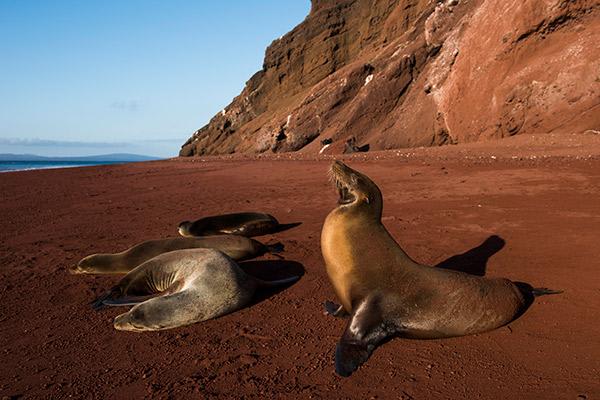
Black Turtle Cove & Bartolome
AM: Enjoy a dinghy ride to Black Turtle Cove on Santa Cruz's north coast. The boat will explore the mangrove-protected cove with the engines off. In the calm waters, you may see sea turtles feeding and mating, along with black-tip, white-tip, and Galapagos sharks. Spot groups of spotted rays, golden cow rays, egrets, and herons.
PM: Bartolome Island is situated across Sullivan Bay. It has an altitude of 114 meters, from where we can observe one of the most beautiful sceneries of the Galapagos Islands such as Volcanic cones, lunar–like craters, lava fields, and the famous Toba formed pinnacle eroded by the sea. It has two breathtaking beaches where marine turtles can be spotted alongside sea lions and at the base o the pinnacle, there is a tiny colony of Galapagos penguins.

Mosquera & North Seymour
AM: Located between North Seymour and Baltra, Mosquera Islet is one of the smallest islands in the Galápagos. It is of volcanic origin, formed by geological uplift, has no visible crater, and its terrain is very flat. One of the most striking features of Mosquera is the contrast of colors. A beautiful beach of white sand, transparent turquoise waters, lush green vegetation, and jet-black lava rocks. Landscape photography is highly recommended here, especially in the golden light conditions of early morning or at sunset.
PM: This remarkable elevated island offers an easy, level walking experience across a pristine landscape. Here, nature provides an intimate theater of Galapagos wildlife. Watch magnificent frigatebirds nesting among the low shrubs, their males displaying their brilliant red throat pouches, while charming blue-footed boobies perform their delightful courtship dances a few feet from the trail. Along the shoreline, playful sea lions ride the waves, while elegant swallow-tailed gulls perch gracefully on the cliffs. Our expert guides will lead you along well-maintained paths, ensuring comfortable viewing of these fascinating creatures in their natural habitat. Your visit can be as active or relaxed as you prefer, with ample opportunities to observe and photograph from convenient resting spots.

El Barranco & Darwin Bay
AM: El Barranco offers an enchanting morning exploration along Darwin Bay's southern edge. This 1.5 km trail traverses volcanic terrain and typically requires two hours at a leisurely pace. The path reveals one of Genovesa's most remarkable bird sanctuaries, where red-footed and masked boobies nest in close proximity. In the cliff's natural cavities, observe fascinating storm petrels and their primary predator, the short-eared owl. The dramatic coastline can be admired both from the trail and during a comfortable panga ride, where you might spot fur sea lions resting on the rocks.
PM: This bay originated when the crater of this island collapsed below sea level. The wet landing is on a beautiful white coral sandy beach. This island is a favorite destination for birdwatchers, allowing the observation of several species including: red-footed boobies, masked boobies, wandering tattlers, lava gulls, whimbrels, yellow-crowned and black-crowned lava herons, and yellow warblers.
Continuing on the trail, visitors can see Red-Foots nesting in the Mangrove trees below. Birdwatching opportunities include sightings of sharp-beaked finches, large cactus and ground finches, Galapagos doves, and swallow-tailed gulls. Alongside the trail, there are tidal pools, here you can observe coastal and sea birds like night herons as well playful sea lions. It is also a very good snorkeling spot to encounter marine life like small reef-trip sharks, sea turtles and hundreds of colorful fish. Sea Kayaking is also possible.
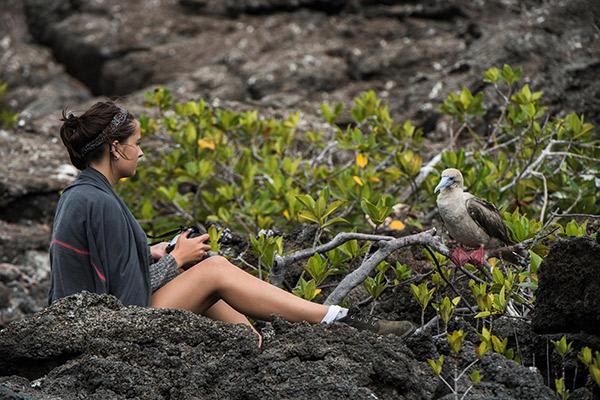
Plazas & Santa Fe
AM: Plazas is located at the east of Santa Cruz Island, and forms part of two islands known as Islas Plazas. Despite its small size, some of the most interesting and outstanding species of the Galapagos are found here. The Plaza's land iguanas are smaller than their relatives found on other islands.
Throughout the island are several hybrid iguanas, a result of crossing a male marine iguana and a female land iguana, they are unique, recognizable at first glance by their black/gray color, with a land iguana’s crest, but face and tail of the marine iguana. The big population of iguanas is due to the presence of tunas, their favorite food. Swallow-tailed gulls nesting in the rugged cliffs is seen along with other seabirds as Audubon shearwaters, red-billed tropicbirds, frigate birds, and brown pelicans.
PM: Located in the southeastern part of the Galapagos, this island was formed from an uplift instead of a volcanic origin, this is why it is mostly flat. Some theories assure this could be the oldest island in the Archipelago. Santa Fe is the home of several endemic species like the Galapagos hawk, Galapagos snake, Galapagos mockingbird, rice rats, and one of the two species of land Iguanas of the islands.
After disembarking in the beautiful and clear waters you will be in contact with one of the many sea lion colonies. Along the trail many salt bushes can be seen as well giant Prickly pear cactus: gigantism is a characteristic of oceanic islands. There are great possibilities of snorkeling with playful sea lions and tropical fish.

Disembarkation
AM: Your final morning in the Galapagos features a visit to the prestigious David Rodriguez Tortoise Center, a conservation jewel dedicated to protecting San Cristóbal's native giant tortoises. Named after a devoted park ranger who served these islands for 39 years, this sophisticated breeding facility plays a crucial role in preserving these magnificent creatures. Located in a serene setting near Cerro Colorado, the center is a 40-minute scenic drive from port through the island's highlands. Here, you'll witness the remarkable Chelonoides chathamensis tortoises in a carefully designed natural habitat. The facility, established in 2002 and refined over the years, represents the pinnacle of conservation excellence in the Galapagos.
Following this memorable encounter, our staff will ensure a seamless transfer to San Cristóbal airport for your departure flight.

Embarkation
AM: Your journey begins with a flight to this remarkable archipelago. Upon arrival, our VIP representatives will assist you with all entry formalities, including the migration card ($20) and National Park fee $200 for adults (as of September 2024) and Children $100 (under 12 years old). After a brief biosecurity clearance, your personal naturalist guide will greet you and escort you to our private transport. While our crew handles your luggage, you'll be transferred to the Seaman Journey via our comfortable tender boat, known locally as a "panga." This short scenic ride delivers you directly to your boutique yacht, where our crew awaits with refreshments to welcome you aboard. We've arranged every detail to ensure your arrival is seamless and comfortable, allowing you to begin your Galapagos adventure in style.
PM: Bartolome Island is situated across Sullivan Bay. It has an altitude of 114 meters (approx. 375 feet), from where we can observe one of the most beautiful sceneries of the Galapagos Islands featuring Volcanic cones, lunar-like craters, lava fields, and the famous Toba-formed pinnacle eroded by the sea. It has two breathtaking beaches where marine turtles can be spotted alongside sea lions and at the base of the pinnacle, there is a tiny colony of Galapagos penguins.
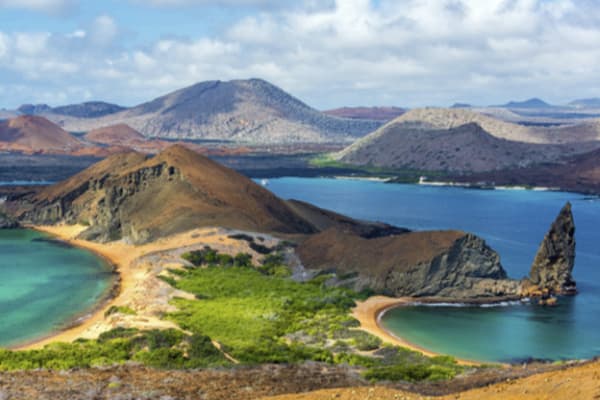
Mosquera Islet & North Seymour
AM: Located between North Seymour and Baltra, Mosquera Islet is one of the smallest islands in the Galápagos. It is of volcanic origin, formed by geological uplift, has no visible crater, and its terrain is very flat. One of the most striking features of Mosquera is the contrast of colors. A beautiful beach of white sand, transparent turquoise waters, lush green vegetation, and jet-black lava rocks. Landscape photography is highly recommended here, especially in the golden light conditions of early morning or at sunset.
PM: This remarkable elevated island offers an easy, level walking experience across a pristine landscape. Here, nature provides an intimate theater of Galapagos wildlife. Watch magnificent frigatebirds nesting among the low shrubs, their males displaying their brilliant red throat pouches, while charming blue-footed boobies perform their delightful courtship dances a few feet from the trail. Along the shoreline, playful sea lions ride the waves, while elegant swallow-tailed gulls perch gracefully on the cliffs. Our expert guides will lead you along well-maintained paths, ensuring comfortable viewing of these fascinating creatures in their natural habitat. Your visit can be as active or relaxed as you prefer, with ample opportunities to observe and photograph from convenient resting spots.
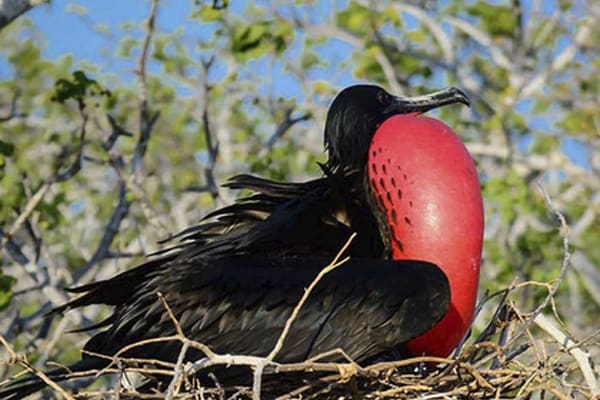
El Barranco & Darwin Bay
AM: El Barranco offers an enchanting morning exploration along Darwin Bay's southern edge. This 1.5 km trail traverses volcanic terrain and typically requires two hours at a leisurely pace. The path reveals one of Genovesa's most remarkable bird sanctuaries, where red-footed and masked boobies nest in close proximity. In the cliff's natural cavities, observe fascinating storm petrels and their primary predator, the short-eared owl. The dramatic coastline can be admired both from the trail and during a comfortable panga ride, where you might spot fur sea lions resting on the rocks.
PM: This bay originated when the crater of this island collapsed below sea level. The wet landing is on a beautiful white coral sandy beach. This island is a favorite destination for birdwatchers, allowing the observation of several species including: red-footed boobies, masked boobies, wandering tattlers, lava gulls, whimbrels, yellow-crowned and black-crowned lava herons, and yellow warblers. Continuing on the trail, visitors can see Red-Foots nesting in the Mangrove trees below. Birdwatching opportunities include sightings of sharp-beaked finches, large cactus and ground finches, Galapagos doves, and swallow-tailed gulls. Alongside the trail, there are tidal pools, here you can observe coastal and sea birds like night herons as well playful sea lions. It is also a very good snorkeling spot to encounter marine life like small reef-trip sharks, sea turtles and hundreds of colorful fish. Sea Kayaking is also possible.

Plazas & Santa Fe
AM: South Plazas is located to the east of Santa Cruz Island and forms part of two islands known as Islas Plazas. Despite its small size, some of the most interesting and outstanding species of the Galapagos are found here. The Plazas land iguanas are smaller than their relatives found on other islands. Throughout the island, there are several hybrid iguanas,a result of crossing a male marine iguana and a female land iguana. They are unique, recognisable at first glance by their black/gray colour, with a land iguana’s crest, but face and tail of the marine iguana. The large population of iguanas is due to the presence of tunas, their favourite food. Swallow-tailed gulls nesting in the rugged cliffs are seen along with other seabirds such as Audubon shearwaters, red-billed tropicbirds, frigate birds, and brown pelicans.
PM: After disembarking in the beautiful and clear waters, you will be in proximity with one of the many sea lion colonies. Along the trail, many salt bushes can be seen as well as giant prickly pear cacti: gigantism is a characteristic of oceanic islands. There are great possibilities for snorkeling with playful sea lions and tropical fish. After disembarking in the beautiful and clear waters, you will be in contact with one of the many sea lion colonies. Along the trail, many salt bushes can be seen as well as giant prickly pear cacti: gigantism is a characteristic of oceanic islands. There are great possibilities for snorkelling with playful sea lions and tropical fish.
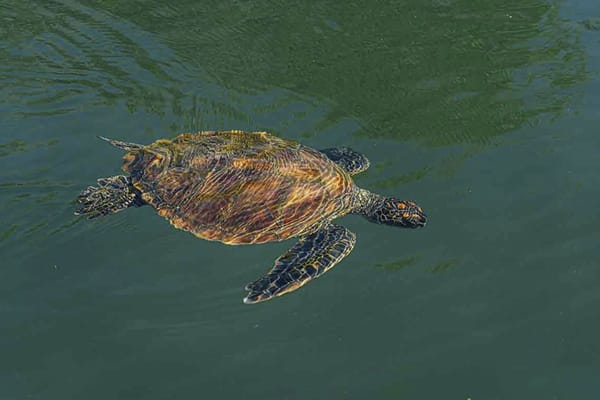
Tortoise Center & Environmental Interpretation Centre
AM: Your morning in the Galapagos starts with a visit to the prestigious David Rodriguez Tortoise Center, a conservation jewel dedicated to protecting San Cristóbal's native giant tortoises. Named after a devoted park ranger who served these islands for 39 years, this sophisticated breeding facility plays a crucial role in preserving these magnificent creatures.Located in a serene setting near Cerro Colorado, the center is a 40-minute scenic drive from port through the island's highlands. Here, you'll witness the remarkable Chelonoides chathamensis tortoises in a carefully designed natural habitat. The facility, established in 2002 and refined over the years, represents the pinnacle of conservation excellence in the Galapagos.
PM: The Gianni Arismendy Environmental Interpretation Centre features lush gardens and stunning ocean views. Here, you will learn about the geological and human history of the islands, conservation facts, and natural history. This center serves as the oldest natural history museum in the Galapagos, striving to preserve the archipelago's unique ecosystem.
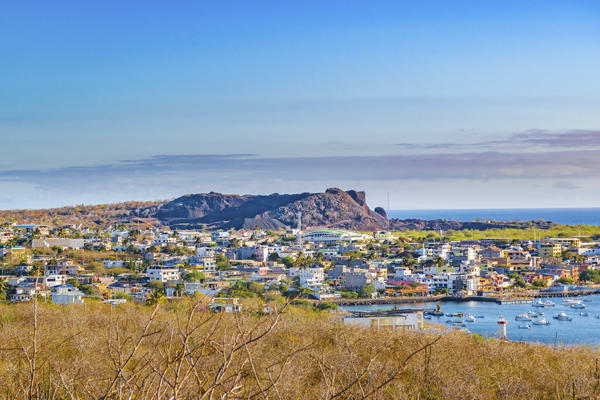
Punta Pitt & Lobos Island
AM: Punta Pitt, located at the eastern end of San Cristobal Island, features a 90-meter beach and several natural viewpoints overlooking an eroded hill of volcanic tuff. A 1,400-meter trail leads from Oliviana Beach to the hilltop, showcasing vibrant colors from various types of lava. Strong winds have created stunning landscapes reminiscent of a science fiction movie. Oliviana Beach's sand, adorned with bright crystals from lava erosion and shells, provides a sunbathing spot for sea lions. Here, you can observe frigate birds, pelicans, herons, and seagulls. Punta Pitt is one of the few places where you can see all three species of boobies—blue-footed, red-footed, and masked—along with two species of frigate birds.
PM: Isla Lobos is a small, flat islet known for its sea lion population, which frolics on the white sand beach. Located about 20 minutes by boat from Puerto Baquerizo Moreno, the island offers excellent snorkeling opportunities. Two strands of beach provide access for tourists to explore the underwater world alongside sea lions. An 850- meter trail connects the brush and features saltwater-tolerant coastal vegetation. It is an important nesting site for blue-footed boobies and frigate birds. One of the easiest islands to walk on as it is flat and everything is very close.
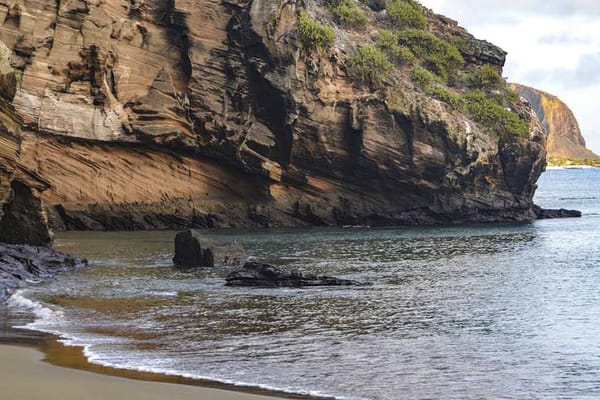
Gardner Bay & Suarez Point
AM: Gardner Bay, located on the northeastern coast of Hood Island, features a beautiful beach for relaxing, swimming, and kayaking. You can spot sea lions, swim with sea turtles and even glimpse small white-tip reef sharks in the clear waters. In this area, you can observe three species of Darwin finches.
PM: Suarez Point is ideal for spotting blue-footed boobies, albatrosses, and Nazca boobies. Set along the oceanfront, this beautiful site features large waved albatrosses launching from cliffs. A famous blowhole here shoots water 50 to 75 meters into the air, offering fantastic photography opportunities.
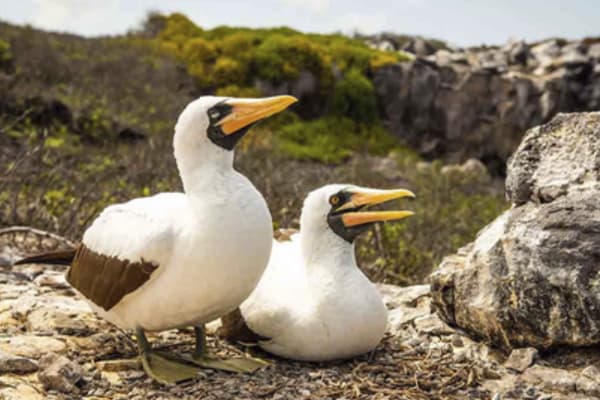
Cormorant Point & Post Office Bay
AM: Cormorant Point likely boasts the best flamingo lagoon in the Galapagos, nestled between two tuff lava cones. You can observe various shorebirds, including common stilts and white-cheeked pintail ducks, alongside the flamingos. The area features two distinct beaches: "Green Beach," with its olivine crystal sand, and "Flour Sand Beach," made of coral. After your exploration, the group will visit Champion Islet, a prime spot for snorkeling with sea turtles, sea lions, and vibrant fish among the nearby coral reefs.
PM: Post Office Bay houses a wooden barrel placed by a whaling ship in the 18th century, serving as a makeshift post office for mariners and tourists. Visitors can hand-deliver letters or postcards. This site also marks the landing area for some of the first colonists. Spend the afternoon relaxing on the beach and enjoying the beauty of the Galapagos.
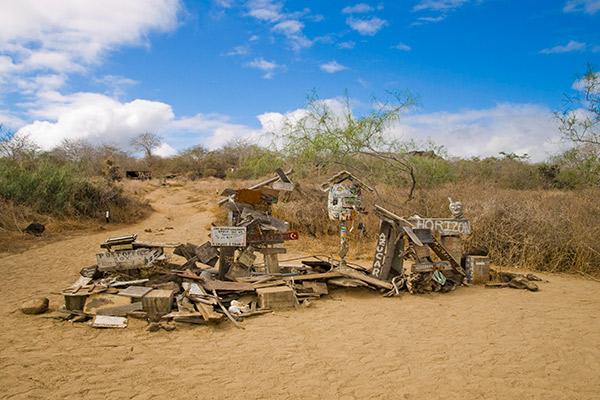
Breeding Centre & Highlands
AM: The Fausto Llerena Breeding Centre, located in the Galapagos National Park on Charles Darwin Avenue, is a 40-minute walk from Gus Angermeyer Tourist Pier. Start your visit at the Galapagos National Park Service information booth. Follow the trail to the Van Straelen Interpretation Centre, then to the breeding center. An elevated wooden path allows you to view several species of Santa Cruz tortoises and the tortoises of Española Island, culminating at the baby-tortoise breeding corral.
PM: The visit to Ranch Manzanillo includes a picnic lunch and a short walk. Santa Cruz offers excellent opportunities to observe the wild Galapagos Tortoises. Tracking tortoises is not the only exciting activity to be found in the highlands. There are also plenty of lava tubes, sinkholes, and craters ready to be explored.
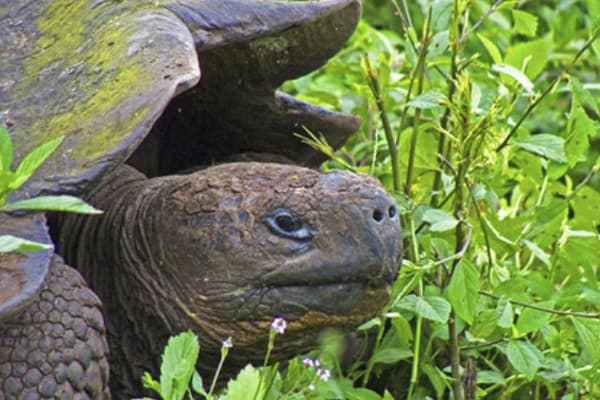
Moreno Point & Mangle Point
AM: Punta Moreno sits on Isabela Island's west coast, at the entrance of the Bolivar channel. The trail follows a Pahoehoe lava flow into coastal lagoons. Spot various bird species including blue footed boobies and flightless cormorants, near the lakes and mangroves.
PM: Mangle Point, off Fernandina's eastern coast, is an excellent snorkeling site. Ride in a panga or zodiac through mangrove groves. You may see sea lions, tortoises, pelicans, rays, and numerous sea birds.
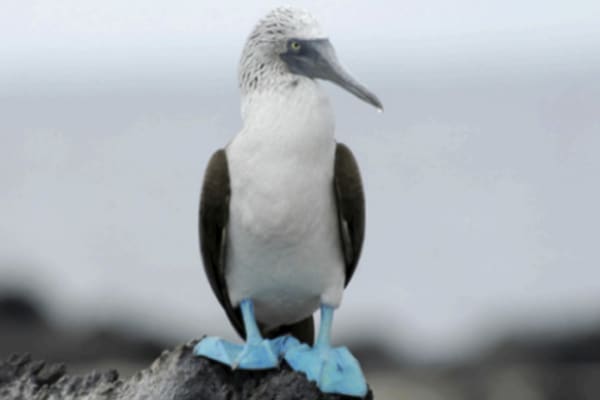
Urbina Bay & Tagus Cove
AM: Urbina Bay sits at the base of Alcedo Volcano on Isabela's west coast. This area uplifted in 1954, stranding marine life. It offers great snorkeling and features a 3,200-meter trail with sand, pumice, lava, coral, and coastal vegetation. Look for iguana burrows and when snorkeling you may swim alongside penguins and observe red and blue lobsters. Here, you might see Darwin's finches and land iguanas, which are larger than those on South Plaza Island. Giant Tortoises also roam the area. The vegetation includes chamomile, Rosewood, and Darwin’s cotton flowers, which are endemic to the Galapagos.
PM: Tagus Cove, west of Darwin Volcano, was a favorite spot for pirates and whalers, it is possible to observe pirate graffitti. You will see a cave with inscriptions from the 1800s. The area is known for volcanic rocks, including "lapilli," small spherical rocks. The trail is a small challenge and leads to a lookout above Darwin lake and the bay below. The trail allows you to spot finches and mockingbirds. It is also a very good snorkeling and sea kayaking spot. There is a colony of flightless cormorants.
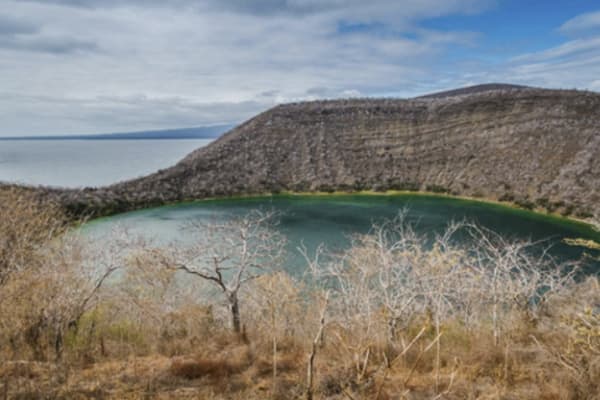
Espinoza Point & Vicente Roca
AM: Espinoza Point is famous for its marine iguana colonies, looking like armies covering entire areas. Also home to unique species like the flightless cormorant, Galapagos penguin, Galapagos hawk, and Galapagos snake. This is one of the most pristine and remote areas of the Galápagos archipelago.
PM: Vicente Roca Point, on Isabela's northwestern coast, features high cliffs and lava formations. This bay is rich in marine life. Look for seahorses, sea turtles, and Mola-mola (sunfish). Enjoy panga rides and snorkeling to see penguins, blue-footed boobies, terns, and sea lions.
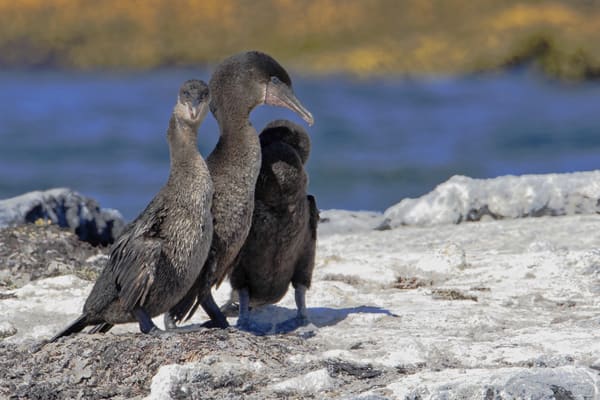
Espumilla Beach & Puerto Egas
AM: Espumilla Beach lies on Santiago Island's northern coast, within James bay. The site has a very picturesque coastline, that shows erosion and different formations created by action of the sea. Explore the palo Santo forest, mangroves and see nesting baby sea turtles in the sand dunes as well as a Flamingo colony in the coastal lagoon. Vegetation varies in short distance from dry to humid, here you can see the damage done by introduced species like feral goats that finally were eradicated. Main wildlife includes sea lions and fur seals, marine turtles, marine iguanas, oystercatchers, herons (great blue heron) and other sea birds. You can also spot land birds like the Galapagos dove, Darwin’s finches and hawks.
PM: Puerto Egas features a black beach with volcanic tuff deposits, there is vibrant contrast between the dark minerals and the red sally-lightfoot crabs that are sprinkled on the rocks. This site was once used for salt extraction, which ended due to low prices on the continent. The abandoned infrastructure remains. The trail passes a sea lion colony and leads to the playful grotto were fur seals (smaller than the sea lions) swim around and play in the tidal pools. Snorkel with marine iguanas, playful sea lions and other marine life.
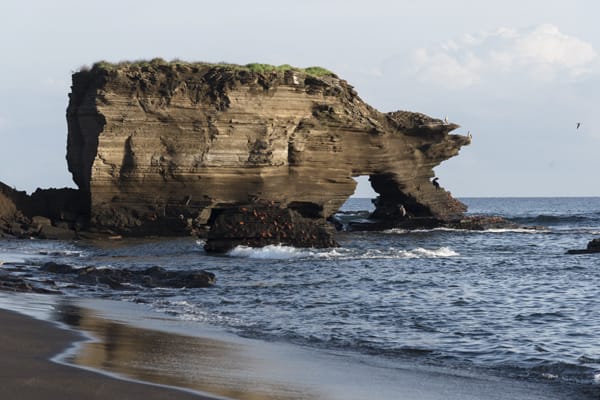
Rabida Island & Chinese Hat
AM: Rábida Island stands out for its red rocks and sand. The volcanic material here is porous, changing color due to oxidation. A short trail leads to a lagoon where you can see land birds and a colony of flamingos. It is interesting to Snorkeling is amongst the best as you swim along the coastline, playful sea lions join you. You can spot moray eels, small sharks, starfish and lots of colorful fish.
PM: Chinese Hat is a small islet off Santiago Island's southeastern tip. This recent volcanic cone resembles a Chinese hat. Explore lava formations and observe sea lion colonies, lava lizards, marine iguanas, and Galapagos penguins. This is an island of colorful contrasts, the red vessuvium flowers, the sally lightfoot crabs and the orange beaks of the American oystercatchers contrast beautifully with the pahoe hoe lava fields and lava cacti. It is also a nice spot for deep water snorkeling, the channel formed between Sombrero Chino and Santiago island creates are protected area with calm turquoise waters, yet deep enough to attract white-tipped reef sharks that sleep in the small caves formed below. You can also observe the rare visit of a whale-shark.
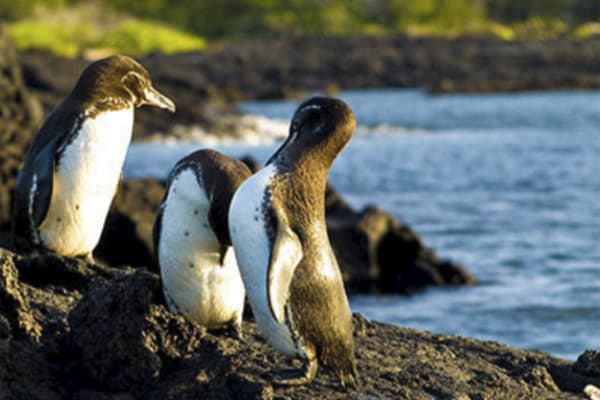
Disembarkation
AM: Enjoy a dinghy ride to Black Turtle Cove on Santa Cruz's north coast. The boat will explore the mangrove-protected cove with the engines off. In the calm waters, you may see sea turtles feeding and mating, along with black-tip, white-tip, and Galapagos sharks. Spot groups of spotted rays, golden cow rays, egrets, and herons.
After the visit, you will be transferred to Baltra airport for your flight back to the mainland.
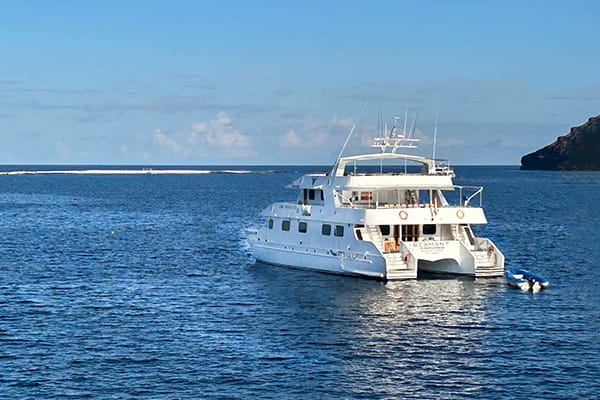
Embarkation
AM: Today, you will fly to the Galapagos Islands. After landing in Santa Cruz, go through an inspection point to prevent the introduction of foreign plants and animals.
Your guide will meet you at the airport, help with your luggage, and take you to the bus for the ferry across the Itabaca Channel. You will then visit Ranch Manzanillo or a similar farm in the highlands of Santa Cruz Island. Wear comfortable shoes, light clothing, and bring a waterproof jacket, sunblock, a camera, and repellent.
PM: Enjoy a picnic lunch and a short walk before boarding the Motor Catamaran. Your luggage will go directly to the Seaman Journey yacht. At Santa Cruz, observe wild Galapagos tortoises. Explore lava tubes, sinkholes, and craters in the highlands. After this visit, you will travel to the M/C Seaman Journey.
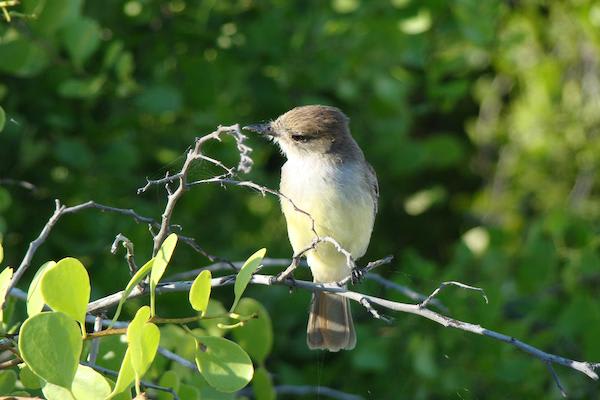
Punta Moreno & Mangle Point
AM: Punta Moreno sits on Isabela Island's west coast, at the entrance of the Bolivar channel. The trail follows a Pahoehoe lava flow into coastal lagoons. Spot various bird species including blue footed boobies and flightless cormorants, near the lakes and mangroves.
PM: Mangle Point, off Fernandina's eastern coast, is an excellent snorkeling site. Ride in a panga or zodiac through mangrove groves. You may see sea lions, tortoises, pelicans, rays, and numerous sea birds.

Urbina Bay & Tagus Cove
AM: Urbina Bay is located at the base of Alcedo Volcano on the west coast, between Tagus Cove and Elizabeth Bay. This area experienced a major uplift in 1954, which caused the land to rise over 16 feet. The coast expanded half a mile out, leaving marine life stranded on the new shore. This area is also a great place to snorkel. Urbina Bay is a path that starts o with a wet landing. The course is approximately 3200m and made up of sand, pumice, lava, coral, and vegetation where one can observe iguana burrows. It is an ideal place to see red and blue lobster! In Bahia Urbina, you can see Darwin's finches. Its main attraction is the land iguanas, which are larger than in places like South Plaza Island and Galapagos tortoises also in the wild, sometimes even out of season, they are on the bottom of the islands. A large amount of vegetation can be observed such as chamomile and Rosewood, but among all these plants, the beautiful flowers of cotton Darwin, endemic to the Galapagos Islands stand out.
PM: Tagus Cove is located west of Darwin Volcano on Isabela Island. This was a favorite spot for pirates and whalers, and it was them who started the following tradition: the inscription of the names of boats. At the beginning of the trail, you will see a small cave where you will and inscriptions dating to the 1800s. Its name originated from a British warship that went across the islands in 1814 looking for Galapagos Tortoise for food. Due to former eruptions, the substrate has a large number of volcanic rocks of different sizes, among the most common, are little balls of the nearly spherical shape known as the "lapilli" or petrified rain.

Espinoza & Vicente Roca Point
AM: Mangle Point, off Fernandina's eastern coast, is an excellent snorkeling site. Ride in a panga or zodiac through mangrove groves. You may see sea lions, tortoises, pelicans, rays, and numerous sea birds.
PM: Mangle Point, off Fernandina's eastern coast, is an excellent snorkeling site. Ride in a panga or zodiac through mangrove groves. You may see sea lions, tortoises, pelicans, rays, and numerous sea birds.

Playa Espumilla & Puerto Egas
AM: Espumilla Beach is located on the northern coast of Santiago Island in James Bay. During the last presence of the El Niño phenomenon, one of the two lagoons in this site, underwent a process of sedimentation, thus causing the disappearance of a representative colony of flamingos. The main attractions are the Palo Santo forest and the nesting of baby turtles.
PM: It's a black beach is located on the west side of the island and is the main attraction of the island. Their volcanic deposits have favored the formation of this special black sand beach. This site is called Puerto Egas because there was an attempt to start the exploitation of salt, which failed. After all, the price of salt in the continent was very cheap and did not justify its exploitation in Galapagos. The project was abandoned and the infrastructure was left abandoned.

Rabida & Chinese Hat Islet
AM: Rábida Island is unique due to the red color that colors all rocks and sand. The volcanic material in this island is very porous and external factors as rain, salty water, and sea breeze have acted as an oxidizing agent. A short walk along a trail leads you to a coastal lagoon behind the beach which permits you to observe the land birds such as finches, doves, yellow warblers, and mockingbirds. At the lagoon, there is a colony of flamingos.
PM: This is a small islet (1 sq km) located just o the southeastern tip of Santiago Island. It is a recent volcanic cone, shaped like a Chinese hat when seen from the north. On the west you can see lava formations, formed under the sea and raised upwards, this is why coral heads are found on the lava. This is an excellent visit for the interpretation of geological features such as lava tubes and lava flows. The landscape is covered by sea lions colonies, marine iguanas, and Galapagos penguins.

Black Turtle Cove & Bartolome
AM: Enjoy a dinghy ride to Black Turtle Cove on Santa Cruz's north coast. The boat will explore the mangrove-protected cove with the engines off. In the calm waters, you may see sea turtles feeding and mating, along with black-tip, white-tip, and Galapagos sharks. Spot groups of spotted rays, golden cow rays, egrets, and herons. After the visit, you will be transferred to Baltra airport for your flight back to the mainland.
PM: Bartolome Island is situated across Sullivan Bay. It has an altitude of 114 meters, from where we can observe one of the most beautiful sceneries of the Galapagos Islands such as Volcanic cones, lunar-like craters, lava fields, and the famous Toba formed pinnacle eroded by the sea. There is very little vegetation on this island. It has two breathtaking beaches where marine turtles exist and at the base of the pinnacle, as well as a very small colony of Galapagos penguins.
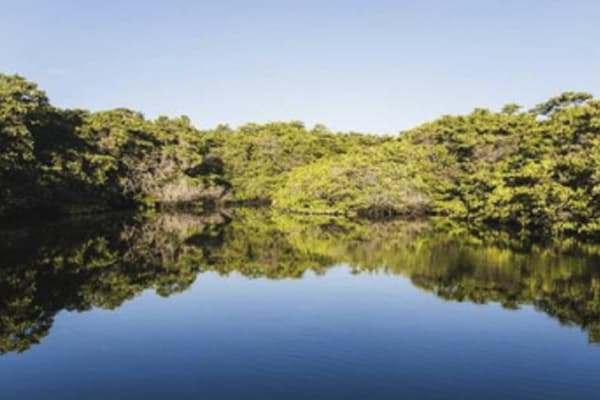
Mosquera Islet & North Seymour
AM: Located between North Seymour and Baltra, Mosquera Islet is one of the smallest islands in the Galápagos. It is of volcanic origin, formed by geological uplift, has no visible crater, and its terrain is very flat. One of the most striking features of Mosquera is the contrast of colors. A beautiful beach of white sand, transparent turquoise waters, lush green vegetation, and jet-black lava rocks. Landscape photography is highly recommended here, especially in the golden light conditions of early morning or at sunset.
PM: This remarkable elevated island offers an easy, level walking experience across a pristine landscape. Here, nature provides an intimate theater of Galapagos wildlife. Watch magnificent frigatebirds nesting among the low shrubs, their males displaying their brilliant red throat pouches, while charming blue-footed boobies perform their delightful courtship dances a few feet from the trail. Along the shoreline, playful sea lions ride the waves, while elegant swallow-tailed gulls perch gracefully on the cliffs. Our expert guides will lead you along well-maintained paths, ensuring comfortable viewing of these fascinating creatures in their natural habitat. Your visit can be as active or relaxed as you prefer, with ample opportunities to observe and photograph from convenient resting spots.
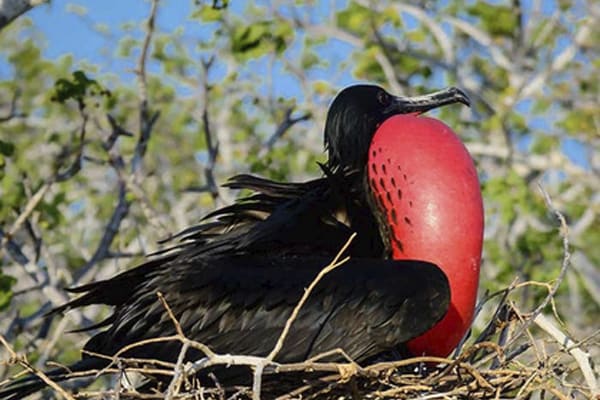
El Barranco & Darwin Bay
AM: El Barranco offers an enchanting morning exploration along Darwin Bay's southern edge. This 1.5 km trail traverses volcanic terrain and typically requires two hours at a leisurely pace. The path reveals one of Genovesa's most remarkable bird sanctuaries, where red-footed and masked boobies nest in close proximity. In the cliff's natural cavities, observe fascinating storm petrels and their primary predator, the short-eared owl. The dramatic coastline can be admired both from the trail and during a comfortable panga ride, where you might spot fur sea lions resting on the rocks.
PM: This bay originated when the crater of this island collapsed below sea level. The wet landing is on a beautiful white coral sandy beach. This island is a favorite destination for birdwatchers, allowing the observation of several species including: red-footed boobies, masked boobies, wandering tattlers, lava gulls, whimbrels, yellow-crowned and black-crowned lava herons, and yellow warblers. Continuing on the trail, visitors can see Red-Foots nesting in the Mangrove trees below. Birdwatching opportunities include sightings of sharp-beaked finches, large cactus and ground finches, Galapagos doves, and swallow-tailed gulls. Alongside the trail, there are tidal pools, here you can observe coastal and sea birds like night herons as well playful sea lions. It is also a very good snorkeling spot to encounter marine life like small reef-trip sharks, sea turtles and hundreds of colorful fish. Sea Kayaking is also possible.
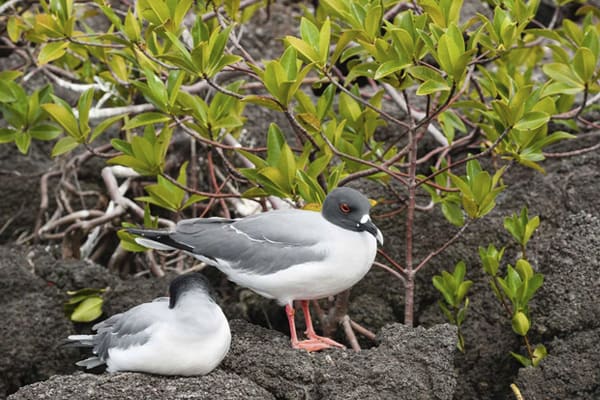
Plazas & Santa Fe
AM: South Plazas is located to the east of Santa Cruz Island and forms part of two islands known as Islas Plazas. Despite its small size, some of the most interesting and outstanding species of the Galapagos are found here. The Plazas land iguanas are smaller than their relatives found on other islands. Throughout the island, there are several hybrid iguanas, a result of crossing a male marine iguana and a female land iguana. They are unique, recognisable at first glance by their black/gray colour, with a land iguana’s crest, but face and tail of the marine iguana. The large population of iguanas is due to the presence of tunas, their favourite food. Swallow-tailed gulls nesting in the rugged cliffs are seen along with other seabirds such as Audubon shearwaters, red-billed tropicbirds, frigate birds, and brown pelicans.
PM: After disembarking in the beautiful and clear waters, you will be in proximity with one of the many sea lion colonies. Along the trail, many salt bushes can be seen as well as giant prickly pear cacti: gigantism is a characteristic of oceanic islands. There are great possibilities for snorkelling with playful sea lions and tropical fish.
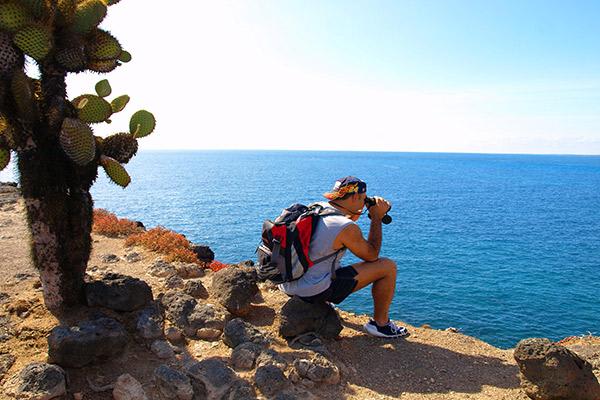
Tortoise Breeding Center & Interpretation Center
AM: The David Rodriguez Tortoise Breeding Centre is located in the southeast of San Cristobal, around 20km from Puerto Baquerizo Moreno. Access is by land; the bus trip takes approximately 40 minutes and is located in the vicinity of Cerro Colorado. This breeding centre has been built to improve the population status of giant tortoises, Chelonoides chathamensis of San Cristobal Island in an environment with conditions similar to their natural state, and in this way, promote the tourist development of San Cristobal.
PM: The Gianni Arismendy Environmental Interpretation Centre features lush gardens and stunning ocean views. Here, you will learn about the geological and human history of the islands, conservation facts, and natural history. This center serves as the oldest natural history museum in the Galapagos, striving to preservethe archipelago's unique ecosystem.

Punta Pitt & Lobos Island
AM: Punta Pitt, located at the eastern end of San Cristobal Island, features a 90-meter beach and several natural viewpoints overlooking an eroded hill of volcanic tuff. A 1,400-meter trail leads from Oliviana Beach to the hilltop, showcasing vibrant colors from various types of lava. Strong winds have created stunning landscapes reminiscent of a science fiction movie. Oliviana Beach's sand, adorned with bright crystals from lava erosion and shells, provides a sunbathing spot for sea lions. Here, you can observe frigate birds, pelicans, herons, and seagulls. Punta Pitt is one of the few places where you can see all three species of boobies—blue-footed, red-footed, and masked—along with two species of frigate birds.
PM: Isla Lobos is a small, flat islet known for its sea lion population, which frolics on the white sand beach. Located about 20 minutes by boat from Puerto Baquerizo Moreno, the island offers excellent snorkeling opportunities. Two strands of beach provide access for tourists to explore the underwater world alongside sea lions. An 850- meter trail connects the brush and features saltwater-tolerant coastal vegetation. It is an important nesting site for blue-footed boobies and frigate birds. One of the easiest islands to walk on as it is flat and everything is very close.
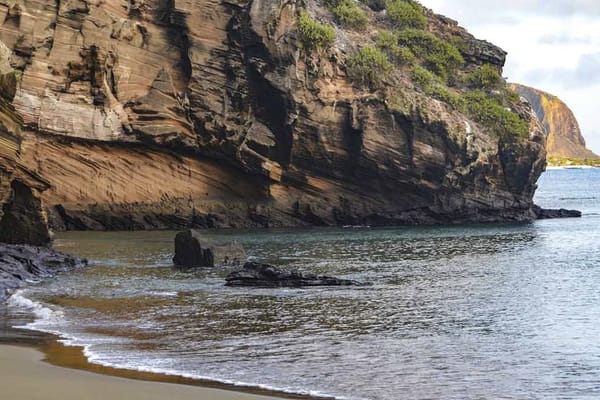
Gardner Bay & Suarez Point
AM: Gardner Bay, located on the northeastern coast of Hood Island, features a beautiful beach for relaxing, swimming, and kayaking. You can spot sea lions, swim with sea turtles and even glimpse small white-tip reef sharks in the clear waters.
PM: Suarez Point is ideal for spotting blue-footed boobies, albatrosses, and Nazca boobies. Set along the oceanfront, this beautiful site features large waved albatrosses launching from cliffs. A famous blowhole here shoots water 50 to 75 meters into the air, offering fantastic photography opportunities.

Cormorant Point & Post Office Bay
AM: Cormorant Point likely boasts the best flamingo lagoon in the Galapagos, nestled between two tuff lava cones. You can observe various shorebirds, including common stilts and white-cheeked pintail ducks, alongside the flamingos. The area features two distinct beaches: "Green Beach," with its olivine crystal sand, and "Flour Sand Beach," made of coral. After your exploration, the group will visit Champion Islet, a prime spot for snorkeling with sea turtles, sea lions, and vibrant fish among the nearby coral reefs.
PM: Post Office Bay houses a wooden barrel placed by a whaling ship in the 18th century, serving as a makeshift post office for mariners and tourists. Visitors can hand-deliver letters or postcards. This site also marks the landing area for some of the first colonists. Spend the afternoon relaxing on the beach and enjoying the beauty of the Galapagos.

Disembarkation
AM: Visit the Fausto Llerena Breeding Centre, located in the Galapagos National Park on Charles Darwin Avenue, is a 40-minute walk from Gus Angermeyer Tourist Pier. Start your visit at the Galapagos National Park Service information booth. Follow the trail to the Van Straelen Interpretation Centre, then to the breeding center. An elevated wooden path allows you to view several species of Santa Cruz tortoises and the tortoises of Española Island, culminating at the baby- tortoise breeding corral.
After your visit, you will transfer to Baltra airport for your flight back to the mainland.
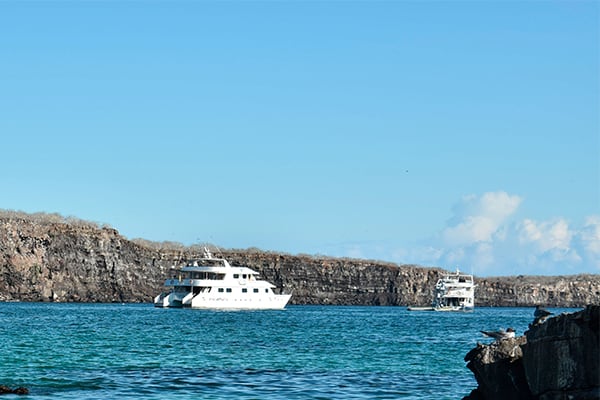
Embarkation
AM: This day you will fly from Quito, Ecuador to the Galapagos. Due to the Galapagos Government, a fee of 20 USD must be paid for the migration control card. Afterward, you will enjoy a quick 4-hour flight, with a quick stop at Guayaquil. Once in San Cristobal, passengers must go through an inspection point at the airport to make sure that no foreign plants or animals are being introduced to the archipelago. Also, this inspection point is where passengers have to pay for the entrance to the Galapagos National Park under the following parameters: Adult Passengers $100 and Children $50 (under 12 years old) Later on, our guide will pick you up and carry the luggage to the bus from the port that transports the passengers to the Seaman Journey Catamaran on a motorized boat called a panga.
PM: This is an interpretation center with exuberant gardens and stunning ocean views. Visitors at the interpretation center can learn a lot from the geological and human history of the islands, conservation facts, and natural history. This is the oldest museum of Natural History in the Galapagos Islands which attempts to preserve the archipelago. It is indeed inspiring and motivating to watch and learn all of their research and attempts.
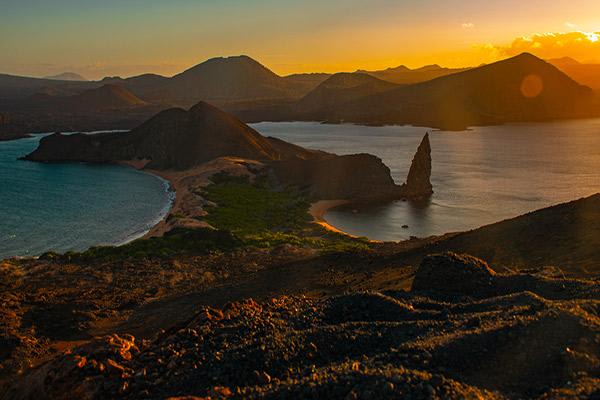
Galapaguera & Cerro Brujo
AM: A short visit will take place at the Galapaguera, a good place to observe Galapagos tortoises in their natural habitat. San Cristobal island has endemic species such as the Mockingbird, lava lizard, Chatham Leaf-toed Gecko, and tortoises. All of these species can be observed in this place, the beach is really big and it works as a nesting zone for marine tortoises. Between January and May, it is common to and the footprints of the female tortoises who have climbed to the dunes to deposit their eggs! This is truly a worth experience to be part of.
PM: Cerro Brujo is a beautiful white coral beach where you can swim and watch birds and sea lions, plus you can snorkel. This is the first coast where Charles Darwin walked on, in 1835. In this marvelous lava landscape, you can watch seabirds like blue-footed boobies, Nazca boobies, herons, frigate birds, and shorebirds. The protected bay is well known for its young tortoises which like to swim around. The pools with salty water behind the dunes were used by the fishermen as a salt mine to preserve food for the local population. Among the fauna, you can observe the Chatham Mockingbird and the San Cristobal Lava Lizard, both species are endemic to the island and unique to the area. Furthermore, you will see the Galapagos turtles and with luck, the little bird is known as the Pájaro Brujo in Spanish, an endemic species in San Cristobal Island. The vegetation covers all the route, where you can nd species like the candelabrum cactus and carob trees. Located on the north coast of Isla San Cristobal it is a peaceful place with white sand and crystal water, a perfect combination for an incredible stay.

Gardner Bay & Suarez Point
AM: Located on the north-eastern coast of Hood, Gardner Bay offers an excellent beach to relax, swim, and even kayak, plus the opportunity to observe sea lions. Here we can also observe sharks in the crystal clear ocean waters. At this place, one can see three species of Darwin finches: A subspecies of the large-billed cactus finch, which is similar to the large-billed terrestrial finch; The small beaked ground finch and the singing finch which is another endemic subspecies. Both resident and migratory birds are observed. It is worth noticing that this zone is really important for marine tortoises' nesting.
PM: This area is great for spotting blue-footed boobies, albatrosses, and Nazca boobies. A beautiful sight on the oceanfront, the large waved albatrosses use the cliff as a launching pad. The famous attraction is the magnificent blowhole, spurting water high into the air at least from 50 to 75 meters high. This site presents wonderful photograph opportunities.
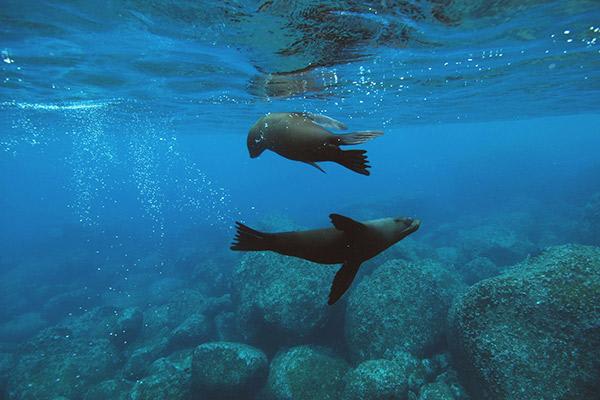
Cormorant Point, Post Office Bay & Baroness Lookout
AM: This site offers probably the best flamingo lagoon in the Galapagos; it is also one of the largest in the islands. It’s situated between two lava cones that give the area a special atmosphere. There are various species of shorebirds to observe besides flamingos; the most frequent are common stilts, white-checked pintail ducks, and other migratory birds. It is very interesting to see the two distinct beaches: “The Green Beach” due to its high percentage of olivine crystals in the sand and the “Flour Sand Beach” which is made up of coral.
PM: Historically, this site is the location of a wooden barrel that was placed in the 18th century by the crew of a whaling ship. It has been used since this time by marines and tourists as a post office. The idea is to carry letters or postcards to their destination by hand. Besides, this site was the landing area for some of the first colonists. We will continue to the north of the island and proceed to an elevated slope to enjoy a beautiful view at the Baroness' lookout. It is said that Baroness Eloisa Von Wagner loved this place and spent several hours watching the horizon. Within walking distance (30 m) are the ruins of what is known as her house. From this lookout, the landscape covers the coastline from the Enderby islet to Post Office Bay, as well as Cerro Pajas, the pool of flamingos, and wide forest of Palo Santo.

Highlands
AM: Journeying across Santa Cruz into the highlands visitors are delighted by the island’s variety of life and geology. Beginning at the coast and traveling across Santa Cruz the road departs from Puerto Ayora climbing through the agricultural lands and into the mist-covered forests. Santa Cruz possesses all of the various life zones present in the archipelago. Birds will surround you across this path. Whether it’s the bright red feathers of a vermillion flycatcher or one of Darwin’s Finch almost every bird present in the islands can be found here.
PM: Santa Cruz offers excellent opportunities to observe the wild Galapagos Tortoises. Tracking tortoises is not the only exciting activity to be found in the highlands. There are also plenty of lava tubes, sinkholes, and craters ready to be explored.
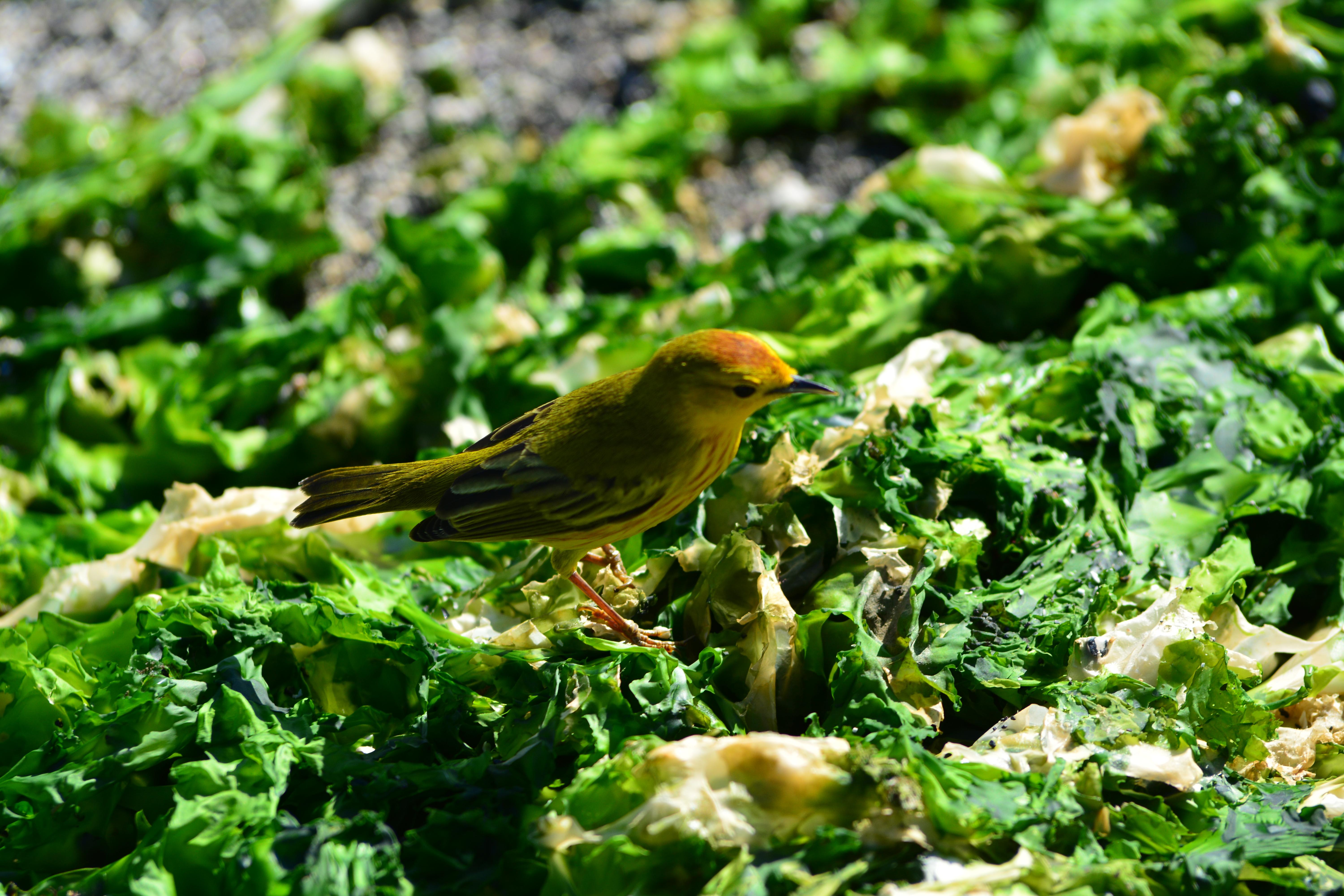
Mangle Point & Punta Moreno
AM: Off the eastern coast of Fernandina, Mangle Point can be found, a superior snorkeling site and a beautiful location for riding in a panga or zodiac through a grove of mangrove trees. A hike of about 1/2 miles is possible. While you are on your ride, you are likely to see sea lions, tortoises, pelicans, rays, and birds too numerous to name them all.
PM: Punta Moreno is located on the north coast of Isabela Island between the volcano Sierra Negra and Cerro Azul volcano. The trail runs along a lava ow Pahohoe into a complex of coastal lagoons, where several species of birds can be found around these lakes and mangroves.

Urbina Bay & Tagus Cove
AM: Urbina Bay is located at the base of Alcedo Volcano on the west coast, between Tagus Cove and Elizabeth Bay. This area experienced a major uplift in 1954, which caused the land to rise over 16 feet. The coast expanded half a mile out, leaving marine life stranded on the new shore. This area is also a great place to snorkel. Urbina Bay is a path that starts o with a wet landing. The course is approximately 3200m and made up of sand, pumice, lava, coral, and vegetation where one can observe iguana burrows. It is an ideal place to see red and blue lobster! In Bahia Urbina, you can see Darwin's finches. Its main attraction is the land iguanas, which are larger than in places like South Plaza Island and Galapagos tortoises also in the wild, sometimes even out of season, they are on the bottom of the islands. A large amount of vegetation can be observed such as chamomile and Rosewood, but among all these plants, the beautiful flowers of cotton Darwin, endemic to the Galapagos Islands stand out.
PM: Tagus Cove is located west of Darwin Volcano on Isabela Island. This was a favorite spot for pirates and whalers, and it was them who started the following tradition: the inscription of the names of boats. At the beginning of the trail, you will see a small cave where you will and inscriptions dating to the 1800s. Its name originated from a British warship that went across the islands in 1814 looking for Galapagos Tortoise for food. Due to former eruptions, the substrate has a large number of volcanic rocks of different sizes, among the most common, are little balls of the nearly spherical shape known as the "lapilli" or petrified rain.

Espinoza Point & Punta Vicente Roca
AM: Espinoza Point is a famous place known for its large colonies of marine iguanas and as the habitat of unique species like the flightless cormorant, Galapagos penguin, Galapagos hawk, and Galapagos snake.
PM: One of the most impressive and spectacular places of the enchanted Galapagos Islands; with high cliff and stone, ash, and lava formations that give this area a majestic touch, is Punta Vicente Roca. It is located on the north-western coast of the island; comprises two distinct islets. This large bay has spectacular marine life. Here, you can see seahorses, sea turtles, and the strange yet fascinating Mola-mola or sunshine. This bay is a great place to practice Panga Ride and Snorkeling. We can as well and: Penguins, Blue-footed boobies, Terns, Boobies, Sea lions. Also, you can snorkel and observe sea turtles, stingrays, and puer shes.

Playa Espumilla & Puerto Egas
AM: Espumilla Beach is located on the northern coast of Santiago Island in James Bay. During the last presence of the El Niño phenomenon, one of the two lagoons in this site, underwent a process of sedimentation, thus causing the disappearance of a representative colony of flamingos. The main attractions are the Palo Santo forest and the nesting of baby turtles.
PM: It's a black beach is located on the west side of the island and is the main attraction of the island. Their volcanic deposits have favored the formation of this special black sand beach. This site is called Puerto Egas because there was an attempt to start the exploitation of salt, which failed. After all, the price of salt in the continent was very cheap and did not justify its exploitation in Galapagos. The project was abandoned and the infrastructure was left abandoned.

Rabida & Chinese Hat Islet
AM: Rábida Island is unique due to the red color that colors all rocks and sand. The volcanic material in this island is very porous and external factors as rain, salty water, and sea breeze have acted as an oxidizing agent. A short walk along a trail leads you to a coastal lagoon behind the beach which permits you to observe the land birds such as finches, doves, yellow warblers, and mockingbirds. At the lagoon, there is a colony of flamingos.
PM: This is a small islet (1 sq km) located just o the southeastern tip of Santiago Island. It is a recent volcanic cone, shaped like a Chinese hat when seen from the north. On the west you can see lava formations, formed under the sea and raised upwards, this is why coral heads are found on the lava. This is an excellent visit for the interpretation of geological features such as lava tubes and lava flows. The landscape is covered by sea lions colonies, marine iguanas, and Galapagos penguins.
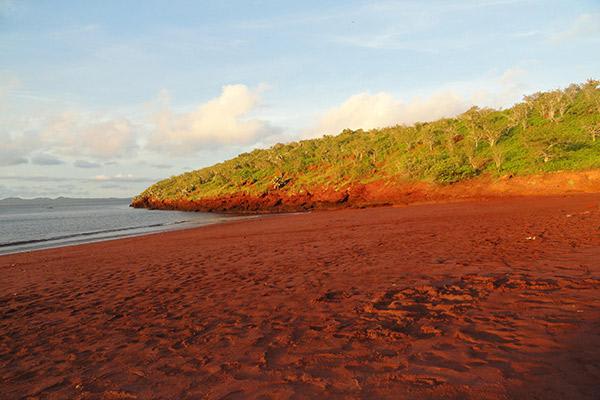
Sullivan Bay & Bartolome
AM: Santiago, also called James, or San Salvador Island is located in the west-central part of the Galapagos archipelago. It is the fourth largest island in the archipelago (following Isabela, Fernandina, and Santa Cruz). Along with some of the large western volcanoes of Isabela and Fernandina, Santiago is also volcanically active, with many young flows and cones to be seen, particularly along the south, west, and east coasts. These may even be seen from the summit of Darwin Volcano and space. Several historic eruptions have been reported over the last 2 centuries. Santiago consists of two coalesced volcanoes: a typical shield volcano on the northwest end and a low, linear fissure volcano on the southeast end.
PM: Bartolome Island is situated across Sullivan Bay. It has an altitude of 114 meters, from where we can observe one of the most beautiful sceneries of the Galapagos Islands such as Volcanic cones, lunar-like craters, lava fields, and the famous Toba formed pinnacle eroded by the sea. There is very little vegetation on this island. It has two breathtaking beaches where marine turtles exist and at the base of the pinnacle, as well as a very small colony of Galapagos penguins.

Bachas Beach & North Seymour
AM: These two small beaches are found to the West of Turtle Cove. Their sand is made of decomposed coral, which makes it white and soft, making it a favorite nesting site for sea turtles. Behind one of the beaches, there is a small brackish water lagoon, where it is occasionally possible to observe flamingos and other coastal birds, such as black-necked stilts and whimbrels. The other beach is longer, but it has two old barges that were abandoned during the Second World War when the USA used Baltra Island as a strategic point to protect the Panama Channel.
PM: North Seymour is an uplifted (as opposed to volcanic) island. Therefore, it is generally flat and strewn with boulders. There are good nesting sites here for a large population of magnificent frigate birds. Blue-footed boobies perform their courtship dance in the more open areas and swallow-tailed gulls perch on the cliff edges.
Despite the tremendous surf that can pound the outer shore, sea lions haul out onto the beach and can be found bodysurfing.

El Barranco & Darwin Bay
AM: The visitor site of El Barranco is located in the southern part of Darwin Bay from Genovesa Island. The trail is on volcanic rock, consists of 1.5 km, and can be done in about 2 hours. The youngest area of the island, from a geological point of view, lies in this area. The cliff is located in the south, is composed of very fragile lava. The natural erosion in these lava flows has become the ideal place for nesting Storm Petrels. You can see two species of petrels that nest in cavities and holes in the lava. One of its main predators is the short-eared owl. The red-footed booby nests only in the outer islands of the archipelago, Punta Pitt, Gardner (Floreana), Wolf, Darwin, and Genovesa. Also present on this island is the masked booby. During the “panga rides” along the cliffs, fur sea lions and several species of seabirds can be seen.
PM: This bay has its origin when the crater of this island collapsed below sea level. The wet landing is on a beautiful white coral sandy beach. This is a favorite island for birdwatchers that allow the following species to be seen: red footed-booby, masked boobies, wandering tattlers, lava gulls, whimbrels, yellow-crowned, and black-crowned lava herons, and yellow warblers. Continuing on the trail, visitors climb gradually to the edge of the cliff seeing Red-Foots nesting in the Mangrove trees below. Bird watching includes sightings of sharp-beaked finches, large cactus and ground finches, Galapagos doves, and swallow-tailed gulls. Reaching the end of the trail, at the cliff's edge, an incredible view of the island and the many birds living there can be observed.
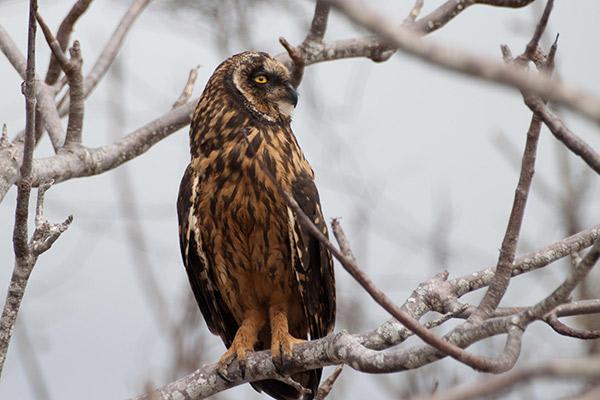
Plazas & Santa Fe
AM: Plazas is located at the east of Santa Cruz Island, and forms part of two islands known as Islas Plazas. Despite its small size, some of the most interesting and outstanding species of the Galapagos are found here. The Plaza's land iguanas are smaller than their relatives found on other islands. Throughout the island are several hybrid iguanas, a result of crossing a male marine iguana and a female land iguana, they are unique, recognizable at first glance by their black/gray color, with a land iguana's crest, but face and tail of the marine iguana. The big population of iguanas is due to the presence of tunas, their favorite food. Swallow-tailed gulls nesting in the rugged cliffs is seen along with other seabirds as Audubon shearwaters, red-billed tropicbirds, frigate birds, and brown pelicans.
PM: Located in the southeastern part of the Galapagos, this island was formed from an uplift instead of a volcanic origin, this is why it is mostly at. Some theories assure this could be the oldest island in the Archipelago. Santa Fe is the home of several endemic species like the Galapagos hawk, Galapagos snake, Galapagos mockingbird, rice rats, and one of the two species of land Iguanas of the islands. After disembarking in the beautiful and clear waters you will be in contact with one of the many sea lion colonies. Along the trail many salt bushes can be seen as well giant Prickly pear cactus: gigantism is a characteristic of oceanic islands. There are great possibilities of snorkeling with playful sea lions and tropical fish.
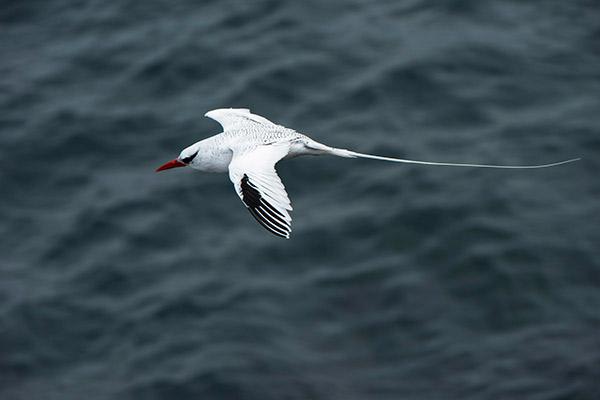
Disembarkation
AM: In 2004 the Breeding and Rearing Center for young tortoises Jacinto Gordillo, named after a famous settler, was located in Cerro Colorado, San Cristobal Island, in order to take care of young tortoises. In 2008 an assisted reproduction program started on the island with due to the birth of a little turtle in captivity. All of this will be learnt at the Jacinto Breeding Center. One can not only learn about breeding processes but as well get engaged and experience why they this breeding centre does what it does.
After the morning excursion you will be taken to the airport for your flight to the mainland.

Accommodations
Social Areas
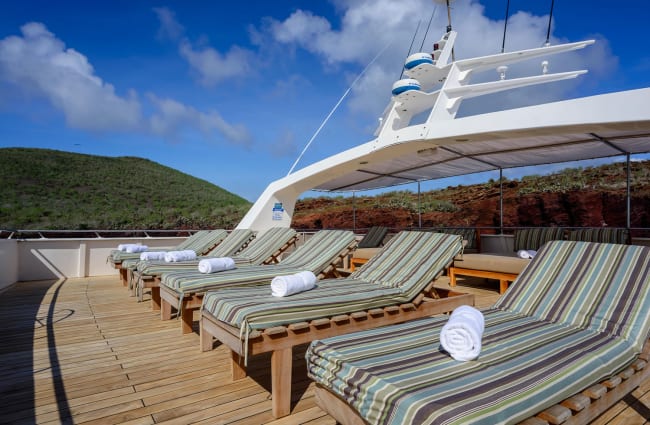

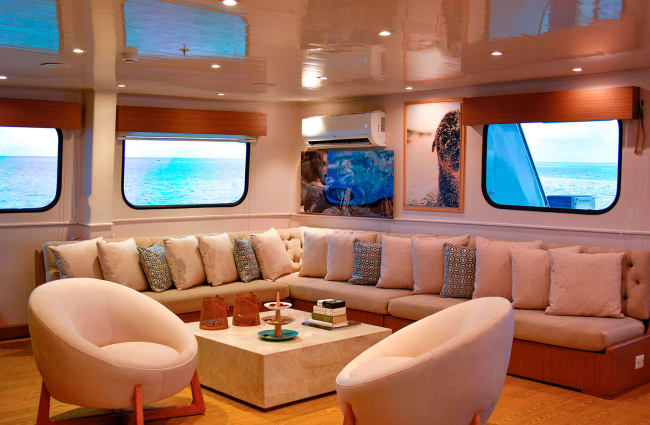
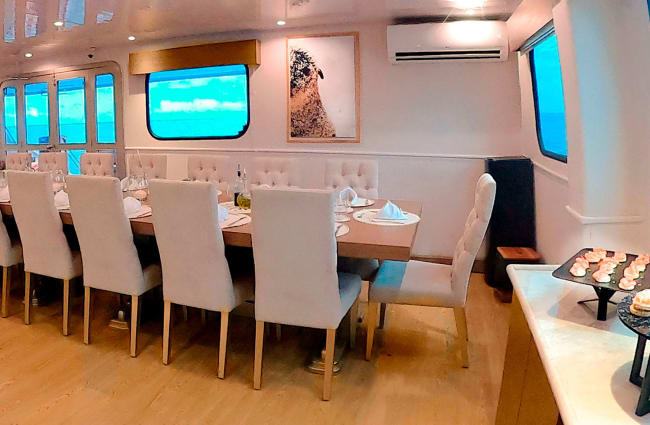
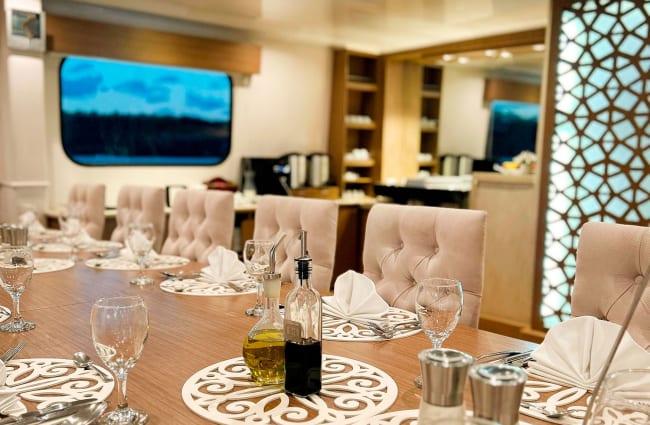
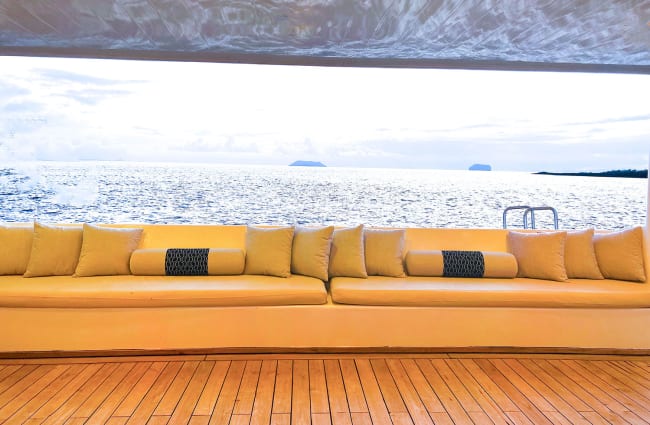
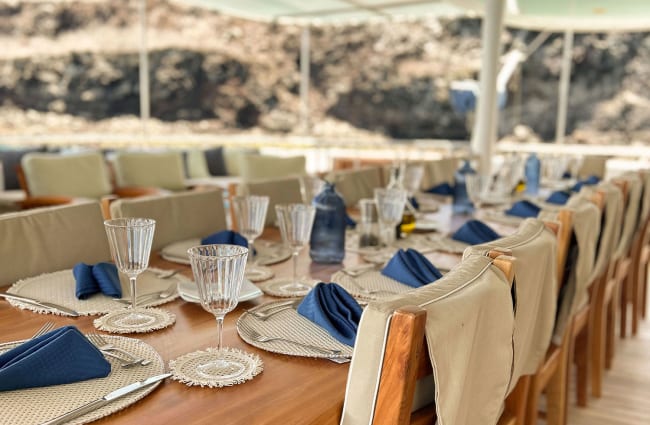
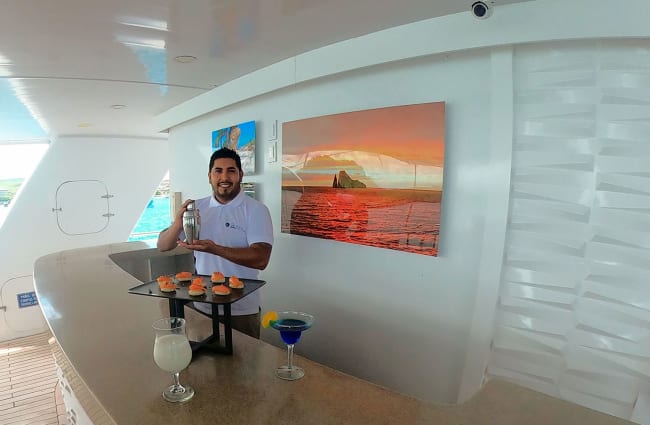
Suites & Cabins
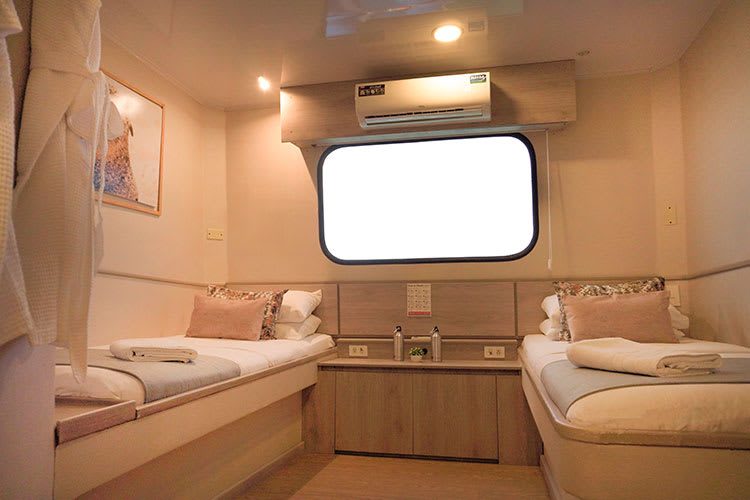

Twin Suite
The Galapagos Seaman Journey has six twin cabins located on the main deck. These cabins offer great comfort with twin beds, a private bathroom, hair dryer, safe, table-lamps and air conditioning. The windows in the cabins offer guests a pleasant panoramic view of the Galapagos landscape.




Matrimonial Suite
The two matrimonial suites are located on the upper deck. These cabins are ideal for couples or honeymooners due to the Queen beds. These cabins feature their own private bathrooms, hair dryer and each have air conditioning. These cabins have the best panoramic view, allowing guests to enjoy the refreshing and warm air of the Galapagos Islands. The double cabins can be converted into a triple by adding a sofa bed. This option is recommended only for small children up to 12 years old.
Related Cruises
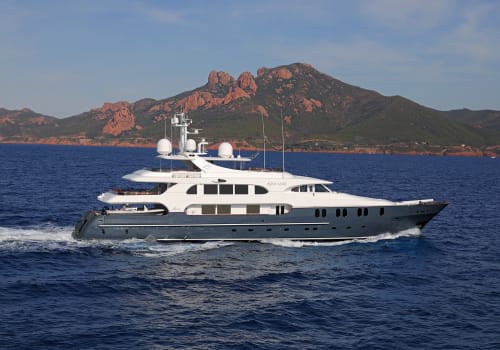
- Galapagos
- Ecuador
Aqua Mare

- Galapagos
- Ecuador
Galaxy Sirius
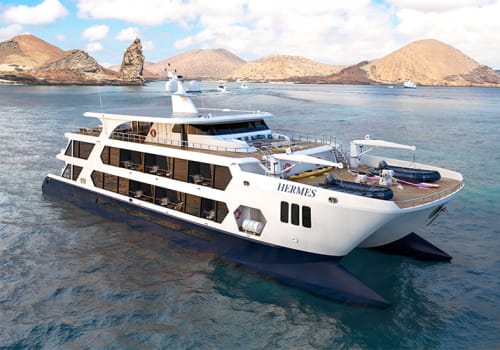
- Galapagos
- Ecuador
Hermes
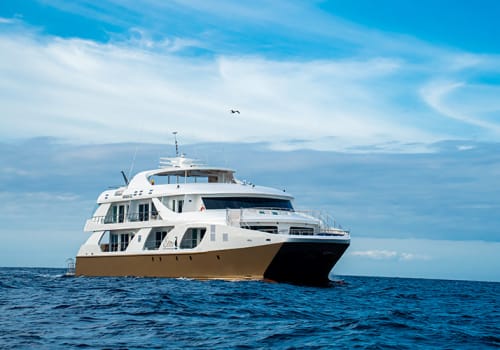
- Galapagos
- Ecuador
Elite
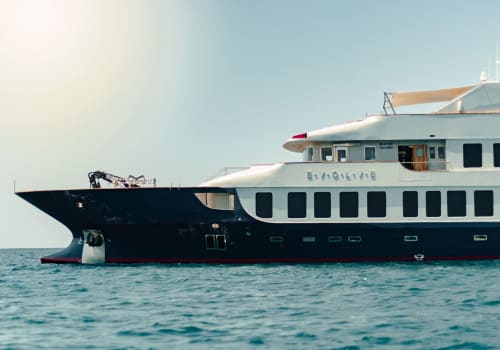
- Galapagos
- Ecuador
Origin, Theory & Evolve

- Galapagos
- Ecuador
Cormorant II
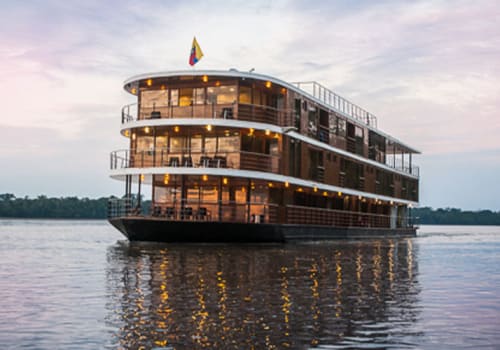
- Amazon
- Ecuador
Anakonda

- Galapagos
- Ecuador
Alya
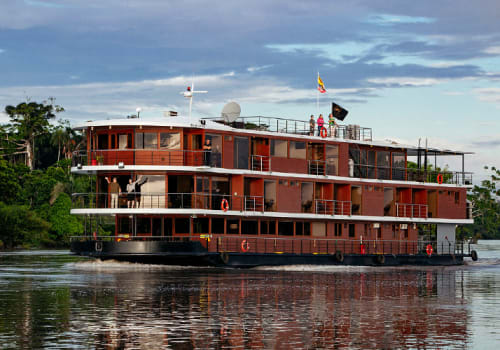
- Amazon
- Ecuador
Manatee Amazon Explorer

- Galapagos
- Ecuador
Endemic
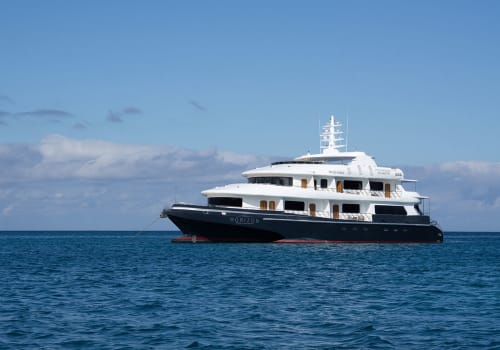
- Galapagos
- Ecuador
Galapagos Horizon
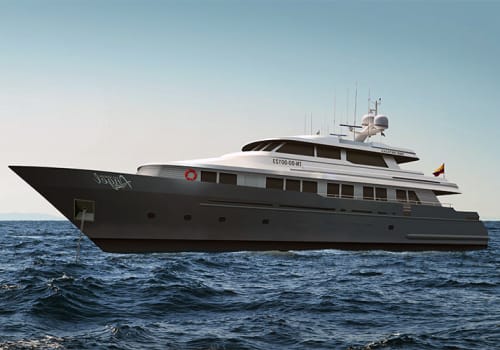
- Galapagos
- Ecuador
Galapagos Angel

- Galapagos
- Ecuador











